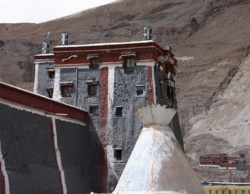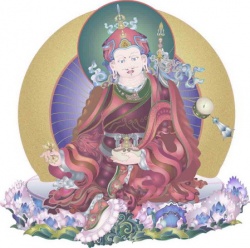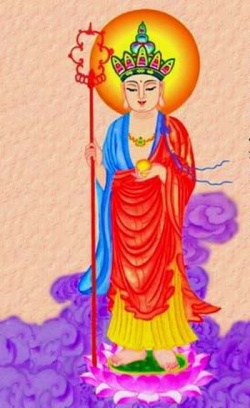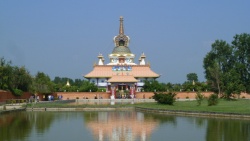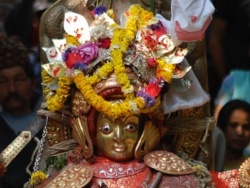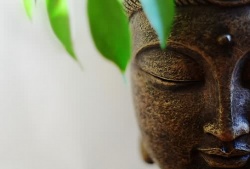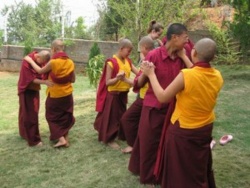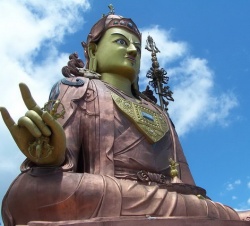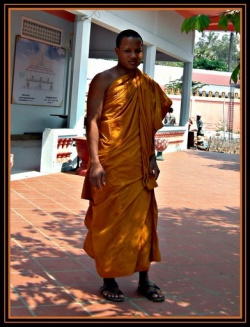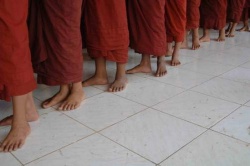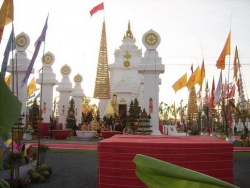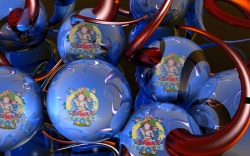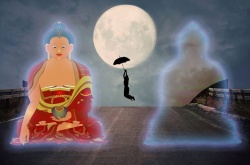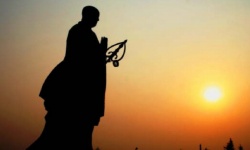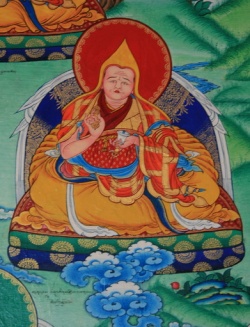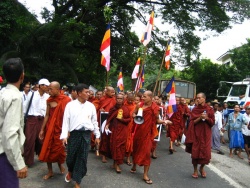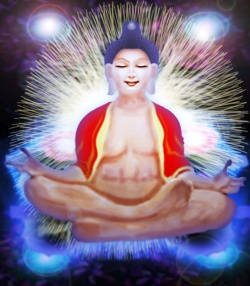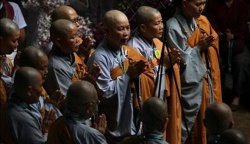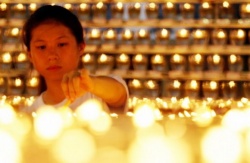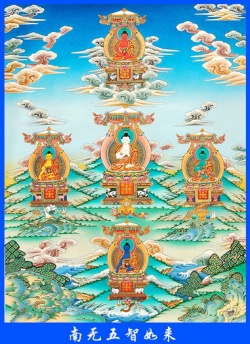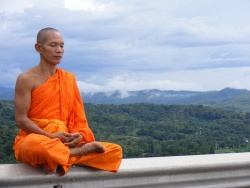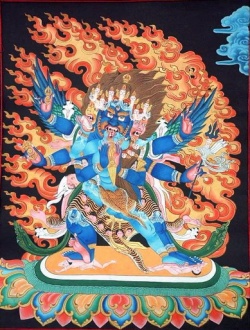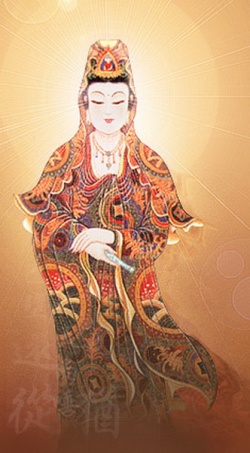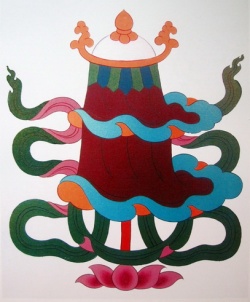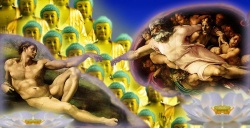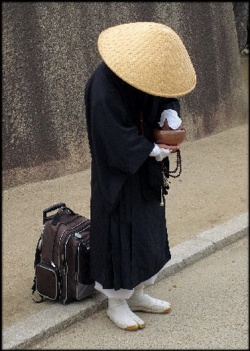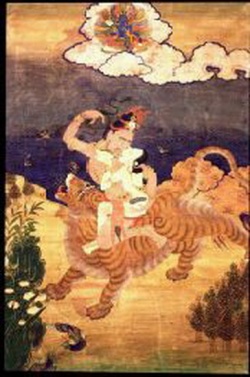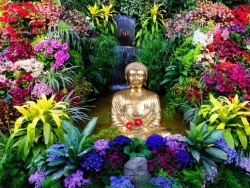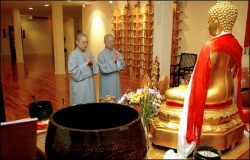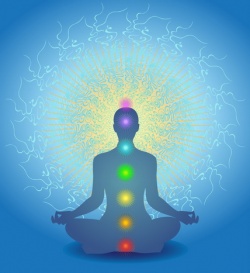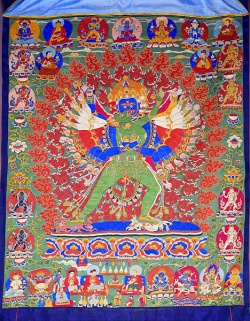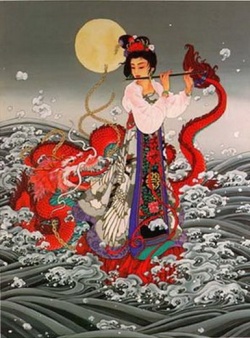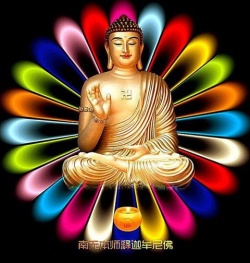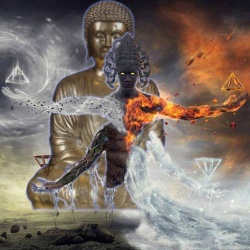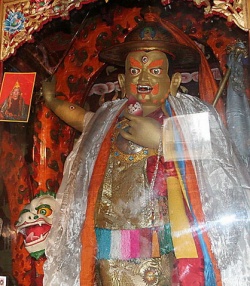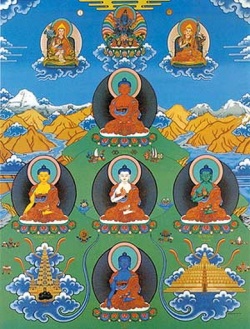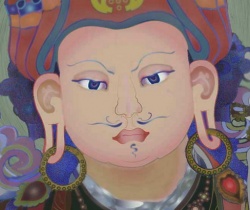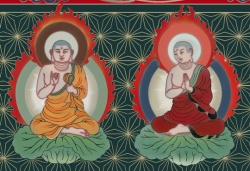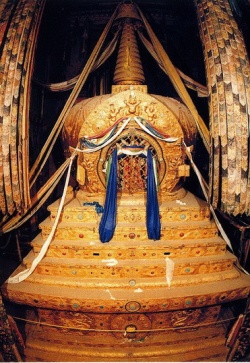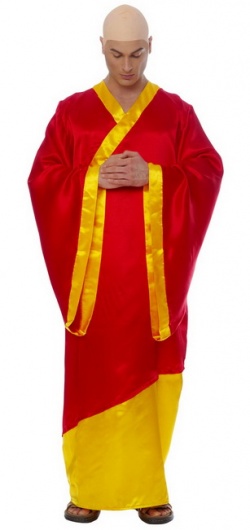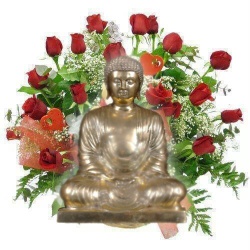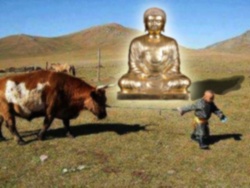Difference between revisions of "Bodhisattvas"
| (3 intermediate revisions by the same user not shown) | |||
| Line 1: | Line 1: | ||
| + | <nomobile>{{DisplayImages|3280|88|144|1546|3093|2722|293|1937|2897|1838|2269|2202|2302|2006|372|2557|1145|693|2119|3710|1706|2807|118|3175|2433|1633|1752|481|2952|1255|4374|2397|801|3708|2923|192|3414|869|1263|4097|1303|4315|742|1856|382|3559|1545|2457|2045|3746}}</nomobile> | ||
<poem> | <poem> | ||
The [[Spiritual Realm]] of the [[Bodhisattva]]: | The [[Spiritual Realm]] of the [[Bodhisattva]]: | ||
| − | The [[Bodhisattva]] is a higher {{Wiki|ideal}} of [[spiritual]] [[aspiration]] than that of the [[Arhat]] | + | The [[Bodhisattva]] is a higher {{Wiki|ideal}} of [[spiritual]] [[aspiration]] than that of the [[Arhat]]. |
| − | + | Whereas the goal of the [[Arhat]] was only [[nirvana]] ([[extinction]] of the asravas1) on the {{Wiki|individual}} level, the goal of the [[Bodhisattva]] is [[Bodhi]] ([[enlightenment]], or [[spiritual]] [[awakening]]) of both oneself and others. | |
| − | + | This is the [[path]] to the [[enlightenment]] of the whole [[world]] ([[Buddha]]). | |
| − | The [[ | + | The [[Bodhisattva]] [[understands]] the [[extinction]] of the [[asravas]] is not an end itself but part of a greater [[spiritual]] [[reality]] that {{Wiki|transcends}} one’s [[own]] [[personal liberation]]. One is not alone - one is part of a [[spiritual]] [[reality]] that is much greater than oneself. There is both one’s [[own]] practice and the influence of others - the two are [[inseparable]] if the [[self]] is not real in and of itself. |
| − | The [[ | + | The [[four truths]] become the springboard for the [[four vows]] that are the resolve of the [[Bodhisattva]]. |
| − | + | The [[path]] of the [[Bodhisattva]] begins with what is known as the first inspiration of the [[awakened mind]] ([[Bodhicitta]]). | |
| − | + | It is this first inspiration of the [[Bodhi mind]] that is the wonderful original [[cause]] of [[enlightenment]], causing one to embark on the [[path]] of [[enlightenment]] and become a [[Buddha]]. | |
| − | Whereas those of the [[Two Vehicles]] are focused on their own practice, the [[Bodhisattvas]] understand that their own practice and the influence of others is an [[inseparable]] dynamic. The [[spiritual realms]] are constantly penetrating, influencing and [[transforming]] each other. | + | Each and every [[cause]] one makes contributes to the [[spiritual]] [[destiny]] of the whole [[world]]. |
| + | |||
| + | The [[life]] of [[Buddha Sakyamuni]] exemplified this. After [[attaining]] [[enlightenment]], | ||
| + | |||
| + | He spent the rest of His [[life]] [[teaching]] and guiding other [[living beings]] towards [[enlightenment]]. | ||
| + | |||
| + | The [[virtues]] of [[mercy]] & [[compassion]] distinguish the [[Bodhisattvas]] from those of the [[Two Vehicles]]. The [[Bodhisattvas]] defer their [[own]] [[liberation]] from the [[threefold realm]] of {{Wiki|mortal}} [[existence]] in [[Life]] & [[Death]] ([[Samsara]]) so that they can help others along the [[path]] to [[spiritual]] [[enlightenment]]. | ||
| + | |||
| + | Whereas those of the [[Two Vehicles]] seek to avoid the [[threefold realm]] through [[detachment]], the [[Bodhisattvas]] have the [[wisdom]] to accept the [[reality]] of the [[threefold realm]] for what it is without being [[attached]] to it and use it as part of the [[vehicle]] for [[attaining]] [[enlightenment]]. | ||
| + | |||
| + | Therefore, instead of separating themselves from [[life]] in this [[world]], the [[Bodhisattvas]] become engaged in it to fulfill their {{Wiki|purpose}} for appearing in it. | ||
| + | |||
| + | Whereas those of the [[Two Vehicles]] only {{Wiki|emphasize}} the [[emptiness]] of all [[existence]], the [[Bodhisattvas]] not only understand this [[emptiness]], but they also understand that which is temporary and provisional in this [[world]] and how it may be used to give [[joy]] and [[happiness]] and help [[guide]] [[living beings]] towards [[enlightenment]]. | ||
| + | |||
| + | The [[Bodhisattva]] is ever on the [[path]] of finding the golden mean between the [[absolute]] and the [[mundane]] that leads to [[enlightenment]]. | ||
| + | |||
| + | Whereas those of the [[Two Vehicles]] are focused on their [[own]] practice, the [[Bodhisattvas]] understand that their [[own]] practice and the influence of others is an [[inseparable]] dynamic. | ||
| + | |||
| + | The [[spiritual realms]] are constantly penetrating, influencing and [[transforming]] each other. | ||
The primary practice of the [[Bodhisattvas]] are the [[Paramitas]], the [[perfections]] that transport them to 'the other shore' of [[enlightenment]]. They are: | The primary practice of the [[Bodhisattvas]] are the [[Paramitas]], the [[perfections]] that transport them to 'the other shore' of [[enlightenment]]. They are: | ||
| Line 34: | Line 53: | ||
First a quote from The Great Calm-Observation regarding ranks: | First a quote from The Great Calm-Observation regarding ranks: | ||
| − | "The [[Scriptures]] and Discourses of the [[Great Vehicle]] all clarify stages and ranks. Those who {{Wiki|fear}} stages and ranks will not enter into any of them. Without avoiding them and without being bound by them, when one has [[equanimity]] with [[respect]] to the [[nature]] of words and designations, there will be {{Wiki|liberated}} [[understanding]]. Although we teach of stages and ranks, one must transcend stages and ranks." | + | |
| + | "The [[Scriptures]] and [[Discourses]] of the [[Great Vehicle]] all clarify stages and ranks. Those who {{Wiki|fear}} stages and ranks will not enter into any of them. Without avoiding them and without being [[bound]] by them, when one has [[equanimity]] with [[respect]] to the [[nature]] of words and designations, there will be {{Wiki|liberated}} [[understanding]]. Although we teach of stages and ranks, one must transcend stages and ranks." | ||
The most commonly cited descriptions of progress along the [[path]] of the [[Bodhisattva]] were The 42 Stages from The [[Flower Garland Sutra]] and The Six {{Wiki|Identities}} With [[Enlightenment]], which [[Chih-I]] gleaned from The [[Lotus Sutra]]. | The most commonly cited descriptions of progress along the [[path]] of the [[Bodhisattva]] were The 42 Stages from The [[Flower Garland Sutra]] and The Six {{Wiki|Identities}} With [[Enlightenment]], which [[Chih-I]] gleaned from The [[Lotus Sutra]]. | ||
In The [[Lotus Sutra]], the forty-two stages are the Practice of the [[Dharma]] ([[Spirituality]]) and are personified by the Provisional [[Bodhisattvas]] whereas the Six {{Wiki|Identities}} are the Practice of [[Faith]] and are personified by the Four Leaders of the [[Bodhisattvas]] that spring forth from the [[earth]]. | In The [[Lotus Sutra]], the forty-two stages are the Practice of the [[Dharma]] ([[Spirituality]]) and are personified by the Provisional [[Bodhisattvas]] whereas the Six {{Wiki|Identities}} are the Practice of [[Faith]] and are personified by the Four Leaders of the [[Bodhisattvas]] that spring forth from the [[earth]]. | ||
| + | |||
| + | |||
| + | [[Bodhisattvas]] | ||
| + | |||
| + | Let us now consider these [[doctrines]] and take first the {{Wiki|worship}} of [[Bodhisattvas]]. | ||
| + | |||
| + | This [[word]] means one whose [[essence]] is [[knowledge]] but is used in the technical [[sense]] of a being who is in process of obtaining but has not yet obtained [[Buddhahood]]. | ||
| + | |||
| + | The [[Pali Canon]] shows little [[interest]] in the [[personality]] of [[Bodhisattvas]] and regards them simply as the preliminary or larval [[form]] of a [[Buddha]], either [[Śâkyamuni]][5] or some of his predecessors. | ||
| + | |||
| + | It was incredible that a being so {{Wiki|superior}} to ordinary [[humanity]] as a [[Buddha]] should be suddenly produced in a [[human]] [[family]] nor could he be regarded as an [[incarnation]] in the strict [[sense]]. | ||
| + | |||
| + | |||
| + | But it was both [[logical]] and edifying to suppose that he was the product of a long [[evolution]] of [[virtue]], of [[good deeds]] and [[noble]] resolutions extending through countless ages and culminating in a being {{Wiki|superior}} to the [[Devas]]. | ||
| + | |||
| + | Such a being awaited in the [[Tushita heaven]] the time fixed for his [[appearance]] on [[earth]] as a [[Buddha]] and his [[birth]] was accompanied by marvels. | ||
| + | |||
| + | But though the [[Pali Canon]] thus [[recognizes]] the [[Bodhisattva]] as a type which, if rare, yet makes its [[appearance]] at certain intervals, it leaves the {{Wiki|matter}} there. It is not suggested that [[saints]] should try to become [[Bodhisattvas]] and [[Buddhas]], or that [[Bodhisattvas]] can be helpers of mankind.[6] | ||
| + | |||
| + | But both these trains of [[thought]] are natural developments of the older [[ideas]] and soon made themselves prominent. | ||
| + | |||
| + | It is a [[characteristic]] [[doctrine]] of [[Mahayanism]] that men can try and should try to become [[Bodhisattvas]]. | ||
| + | |||
| + | |||
| + | |||
| + | In the [[Pali Canon]] we hear of [[Arhats]], [[Pacceka Buddhas]], and {{Wiki|perfect}} [[Buddhas]]. | ||
| + | |||
| + | For all three the [[Wikipedia:Absolute (philosophy)|ultimate]] goal is the same, namely [[Nirvana]], but a [[Pacceka Buddha]] is greater than an [[Arhat]], because he has greater [[intellectual]] [[powers]] though he is not [[omniscient]], and a {{Wiki|perfect}} [[Buddha]] is greater still, partly because he is [[omniscient]] and partly because he saves others. | ||
| + | |||
| + | But if we admit that the career of the [[Buddha]] is better and nobler, and also that it is, as the Introduction to the [[Jâtaka]] recounts, simply the result of an earnest resolution to school himself and help others, kept firmly through the long chain of [[existences]], there is nothing [[illogical]] or presumptuous in making our goal not the quest of personal {{Wiki|salvation}}, but the [[attainment]] of [[Bodhisattvaship]], that is the [[state]] of those who may aspire to become [[Buddhas]]. | ||
| + | |||
| + | In fact the [[Arhat]], engrossed in his [[own]] {{Wiki|salvation}}, is excused only by his [[humility]] and is open to the charge of [[selfish]] [[desire]], since the [[passion]] for [[Nirvana]] is an [[ambition]] like any other and the quest for {{Wiki|salvation}} can be best followed by devoting oneself entirely to others. | ||
| + | |||
| + | |||
| + | But though my [[object]] here is to render intelligible the [[Mahayanist]] point of view including its objections to [[Hinayanism]], I must defend the [[latter]] from the accusation of [[selfishness]]. | ||
| + | |||
| + | The vigorous and authoritative [[character]] of [[Gotama]] led him to regard all mankind as patients requiring treatment and to {{Wiki|emphasize}} the [[truth]] that they could cure themselves if they would try. | ||
| + | |||
| + | |||
| + | But the [[Buddhism]] of the [[Pali Canon]] does not ignore the duties of [[loving]] and instructing others;[7] it merely insists on man's power to save himself if properly instructed and bids him do it at once: "sell all that thou hast and follow me." | ||
| + | |||
| + | And the [[Mahayana]], if less self-centred, has also less [[self-reliance]], and [[self-discipline]]. It is more [[human]] and charitable, but also more easygoing: it teaches the believer to lean on external supports which if well chosen may be a help, but if trusted [[without discrimination]] become paralyzing abuses. | ||
| + | |||
| + | And if we look at the abuses of both systems the fossilized [[monk]] of the [[Hinayana]] will compare favourably [9] with the [[tantric]] {{Wiki|adept}}. | ||
| + | |||
| + | It was to the [[corruptions]] of the [[Mahayana]] rather than of the [[Hinayana]] that the [[decay]] of [[Buddhism in India]] was due. | ||
| + | |||
| + | |||
| + | |||
| + | The career of the [[Bodhisattva]] was early divided into stages (bhûmi) each marked by the acquisition of some [[virtue]] in his triumphant course. | ||
| + | |||
| + | The stages are variously reckoned as five, seven and ten. | ||
| + | |||
| + | The [[Mahâvastu]],[8] which is the earliest work where the progress is described, enumerates ten without distinguishing them very clearly. | ||
| + | |||
| + | Later writers commonly look at the [[Bodhisattva's]] task from the humbler point of view of the beginner who wishes to learn the {{Wiki|initiatory}} stages. | ||
| + | |||
| + | For them the [[Bodhisattva]] is primarily not a [[supernatural]] being or even a [[saint]] but simply a [[religious]] [[person]] who wishes to perform the duties and enjoy the privileges of the {{Wiki|Church}} to the full, much like a communicant in the [[language]] of contemporary [[Christianity]]. | ||
| + | |||
| + | |||
| + | |||
| + | We have a manual for those who would follow this [[path]], in the [[Bodhicaryâvatâra]] of Śântideva, which in its [[humility]], sweetness and fervent piety has been rightly compared with the De Imitatione Christi. | ||
| + | |||
| + | In many respects the [[virtues]] of the [[Bodhisattva]] are those of the [[Arhat]]. | ||
| + | |||
| + | His will must be strenuous and [[concentrated]]; he must cultivate the strictest [[morality]], [[patience]], [[energy]], [[meditation]] and [[knowledge]]. | ||
| + | |||
| + | But he is also a [[devotee]], a [[bhakta]]: he adores all the [[Buddhas]] of the {{Wiki|past}}, {{Wiki|present}} and {{Wiki|future}} as well as sundry superhuman [[Bodhisattvas]], and he confesses his [[sins]], not after the fashion of the [[Pâtimokkha]], but by accusing himself before these [[heavenly]] [[Protectors]] and vowing to [[sin]] no more. | ||
| + | |||
| + | |||
| + | Śântideva lived in the seventh century[9] but tells us that he follows the [[scriptures]] and has nothing new to say. | ||
| + | |||
| + | This seems to be true for, though his [[book]] being a manual of [[devotion]] presents its subject-matter in a [[dogmatic]] [[form]], its main [[ideas]] are stated and even elaborated in the [[Lotus]]. | ||
| + | |||
| + | Not only are {{Wiki|eminent}} figures in the {{Wiki|Church}}, such as [[Sâriputra]] and [[Ânanda]], there designated as [[future Buddhas]], but the same [[dignity]] is predicted wholesale for five hundred and again for two thousand [10][[monks]] while in [[Chapter]] x is sketched the course to be followed by "young men or young ladies of good [[family]]" who wish to become [[Bodhisattvas]].[10] | ||
| + | |||
| + | The chief difference is that the [[Bodhicaryâvatâra]] portrays a more [[spiritual life]], it speaks more of [[devotion]], less of the million shapes that compose the [[heavenly]] host: more of [[love]] and [[wisdom]], less of the [[merits]] of reading particular [[sûtras]]. | ||
| + | |||
| + | While rendering to it and the [[faith]] that produced it all honour, we must remember that it is typical of the [[Mahayana]] only in the [[sense]] that the De Imitatione Christi is typical of {{Wiki|Roman Catholicism}}, for both [[faiths]] have other sides. | ||
| + | |||
| + | |||
| + | Śântideva's [[Bodhisattva]], when [[conceiving]] the [[thought]] of [[Bodhi]] or eventual [[supreme enlightenment]] to be obtained, it may be, only after numberless [[births]], [[feels]] first a [[sympathetic joy]] in the [[good actions]] of [[all living beings]]. | ||
| + | |||
| + | He addresses to the [[Buddhas]] a [[prayer]] which is not a mere act of commemoration, but a request to {{Wiki|preach}} the law and to defer their entrance into [[Nirvana]]. | ||
| + | |||
| + | He then makes over to others whatever [[merit]] he may possess or acquire and offers himself and all his possessions, [[moral]] and material, as a [[Wikipedia:sacrifice|sacrifice]] for the {{Wiki|salvation}} of all [[beings]]. | ||
| + | |||
| + | This on the one hand does not much exceed the limits of [[dânam]] or the [[virtue]] of giving as practiced by [[Śâkyamuni]] in previous [[births]] according to the [[Pali scriptures]], but on the other it contains in [[embryo]] the [[doctrine]] of vicarious [[merit]] and {{Wiki|salvation}} through a saviour. | ||
| + | |||
| + | The older [[tradition]] admits that the [[future Buddha]] (e.g. in the [[Vessantara]] birth-story) gives all that is asked from him including [[life]], wife and children. | ||
| + | |||
| + | To consider the surrender and transfer of [[merit]] ([[pattidâna]] in [[Pali]]) as parallel is a natural though perhaps false analogy. But the transfer of [[Karma]] is not altogether foreign to [[Brahmanic]] [[thought]], for it is held that a wife may share in her husband's [[Karma]] nor is it wholly unknown to {{Wiki|Sinhalese}} [[Buddhism]].[11] | ||
| + | |||
| + | After thus deliberately rejecting all personal [[success]] and [[selfish]] aims, the neophyte makes a [[vow]] ([[praṇidhâna]]) to acquire [[enlightenment]] for the good of all [[beings]] and not to swerve from the {{Wiki|rules}} of [[life]] and [[faith]] requisite for this end. | ||
| + | |||
| + | He is then a "son [11]of [[Buddha]]," a [[phrase]] which is merely a natural {{Wiki|metaphor}} for saying that he is one of the household of [[faith]][12] but still paves the way to later [[ideas]] which make the [[celestial]] [[Bodhisattva]] an [[emanation]] or [[spiritual]] son of a [[celestial]] [[Buddha]]. | ||
| + | |||
| + | |||
| + | |||
| + | [[Asanga]] gives[13] a more technical and {{Wiki|scholastic}} description of the ten [[bhûmis]] or stages which mark the [[Bodhisattva's]] progress towards [[complete enlightenment]] and culminate in a phase bearing the remarkable but [[ancient]] [[name]] of [[Dharmamegha]] known also to the [[Yoga]] [[philosophy]]. | ||
| + | |||
| + | The other stages are called: [[muditâ]] ([[joyful]]): vimalâ (immaculate): [[prabhâkarî]] ({{Wiki|light}} giving): [[arcismatî]] (radiant): [[durjaya]] (hard to gain): [[abhimukhî]] (facing, because it faces both [[transmigration]] and [[Nirvana]]): [[dûramgamâ]] (far-going): [[acalâ]] ([[immovable]]): [[sâdhumatî]] (good minded). | ||
| + | |||
| + | |||
| + | The [[incarnate]] [[Buddhas]] and [[Bodhisattvas]] of [[Tibet]] are a travesty of the [[Mahayana]] which on [[Indian]] soil adhered to the [[sound doctrine]] that [[saints]] are known by their achievements as men and cannot be selected among {{Wiki|infant}} prodigies.[14] | ||
| + | |||
| + | It was the general though not [[universal]] opinion that one who had entered on the career of a [[Bodhisattva]] could not fall so low as to be [[reborn]] in any [[state]] of {{Wiki|punishment}}, but the [[spirit]] of [[humility]] and self-effacement which has always marked the [[Buddhist]] {{Wiki|ideal}} tended to represent his {{Wiki|triumph}} as incalculably distant. | ||
| + | |||
| + | Meanwhile, although in the whirl of [[births]] he was on the upward grade, he yet had his ups and downs and there is no {{Wiki|evidence}} that [[Indian]] or Far Eastern [[Buddhists]] arrogated to themselves special claims and [[powers]] on the ground that they were well advanced in the career of [[Buddhahood]]. | ||
| + | |||
| + | The [[vow]] to suppress [[self]] and follow the {{Wiki|light}} not only in this [[life]] but in all {{Wiki|future}} [[births]] contains an [[element]] of [[faith]] or [[fantasy]], but has any [[religion]] formed a nobler or even {{Wiki|equivalent}} picture of the soul's [[destiny]] or built a better staircase from the [[world]] of men to the [[immeasurable]] [[spheres]] of the superhuman? | ||
| + | |||
| + | |||
| + | One aspect of the story of [[Sâkyamuni]] and his antecedent [[births]] thus led to the [[idea]] that all may become [[Buddhas]]. An [12] equally natural [[development]] in another [[direction]] created [[celestial]] and superhuman [[Bodhisattvas]]. | ||
| + | |||
| + | The [[Hinayana]] held that [[Gotama]], before his last [[birth]], dwelt in the [[Tushita heaven]] enjoying the power and [[splendour]] of an [[Indian]] [[god]] and it looked forward to the advent of [[Maitreya]]. | ||
| + | |||
| + | But it admitted no other [[Bodhisattvas]], a consequence apparently of the [[doctrine]] that there can only be one [[Buddha]] at a time. | ||
| + | |||
| + | But the luxuriant fancy of [[India]], which loves to multiply [[divinities]], soon broke through this restriction and fashioned for itself beautiful images of {{Wiki|benevolent}} [[beings]] who refuse the [[bliss]] of [[Nirvana]] that they may alleviate the [[sufferings]] of others.[15] | ||
| + | |||
| + | So far as we can [[judge]], the figures of these [[Bodhisattvas]] took shape just about the same time that the personalities of [[Vishnu]] and [[Śiva]] were acquiring consistency. | ||
| + | |||
| + | The impulse in both cases is the same, namely the [[desire]] to express in a [[form]] accessible to [[human]] [[prayer]] and sympathetic to [[human]] [[emotion]] the forces which {{Wiki|rule}} the [[universe]]. | ||
| + | |||
| + | But in this work of portraiture the [[Buddhists]] laid more {{Wiki|emphasis}} on [[moral]] and [[spiritual]] law than did the [[Brahmans]]: they isolated in {{Wiki|personification}} qualities not found isolated in [[nature]]. | ||
| + | |||
| + | |||
| + | [[Śiva]] is the law of change, of [[death]] and [[rebirth]], with all the riot of slaughter and priapism which it entails: [[Vishnu]] is the [[protector]] and preserver, the type of good [[energy]] warring against [[evil]], but the {{Wiki|unity}} of the figure is smothered by [[mythology]] and broken up into various [[incarnations]]. | ||
| + | |||
| + | But [[Avalokita]] and [[Mañjuśrî]], though they had not such strong [[roots]] in [[Indian]] [[humanity]] as [[Śiva]] and [[Vishnu]], are genii of purer and brighter presence. | ||
| + | |||
| + | They are the personifications of [[kindness]] and [[knowledge]]. | ||
| + | |||
| + | Though manifold in shape, they have little to do with [[mythology]], and are analogous to the {{Wiki|archangels}} of [[Christian]] and [[Wikipedia:Judaism|Jewish]] [[tradition]] and to the Amesha Spentas of {{Wiki|Zoroastrianism}}. | ||
| + | |||
| + | With these [[latter]] they may have some historical connection, for [[Persian]] [[ideas]] may well have influenced [[Buddhism]] about the time of the [[Christian]] {{Wiki|era}}. | ||
| + | |||
| + | However difficult it may be to prove the foreign origin of [[Bodhisattvas]], few of them have a clear origin in [[India]] and all of them [13] are much better known in {{Wiki|Central Asia}} and [[China]]. | ||
| + | |||
| + | But they are represented with the [[appearance]] and [[attributes]] of [[Indian]] [[Devas]], as is natural, since even in the [[Pali Canon]] [[Devas]] [[form]] the [[Buddha's]] retinue. | ||
| + | |||
| + | The early [[Buddhists]] considered that these [[spirits]], whether called [[Bodhisattvas]] or [[Devas]], had [[attained]] their high position in the same way as [[Śâkyamuni]] himself, that is by the practice of [[moral]] and [[intellectual]] [[virtues]] through countless [[existences]], but subsequently they came to be regarded as [[emanations]] or sons of superhuman [[Buddhas]]. | ||
| + | |||
| + | Thus the [[Kâraṇḍa-vyûha]] relates how the original [[Âdi-Buddha]] produced [[Avalokita]] by [[meditation]] and how he in his turn produced the [[universe]] with its [[gods]]. | ||
| + | |||
| + | |||
| + | |||
| + | Millions of unnamed [[Bodhisattvas]] are freely mentioned and even in the older [[books]] copious lists of names are found,[16] but two, [[Avalokita]] and [[Mañjuśrî]], tower above the rest, among whom only few have a definite [[personality]]. | ||
| + | |||
| + | The [[tantric school]] counts eight of the first rank. [[Maitreya]] (who does not stand on the same footing as the others), | ||
| + | |||
| + | [[Samantabhadra]], [[Mahâsthâna-prâpta]] and above all [[Kshitigarbha]], have some importance, especially in [[China]] and [[Japan]]. | ||
| + | |||
| + | |||
| + | |||
| + | [[Avalokita]][17] in many [[forms]] and in many ages has been one of the [[principal]] [[deities]] of {{Wiki|Asia}} but his origin is obscure. His main [[attributes]] are plain. | ||
| + | |||
| + | He is the {{Wiki|personification}} of [[divine]] [[mercy]] and [[pity]] but even the meaning of his [[name]] is [[doubtful]]. In its full [[form]] it is [[Avalokiteśvara]], often rendered the [[Lord who looks down]] (from [[heaven]]). | ||
| + | |||
| + | This is an appropriate title for the [[God]] of [[Mercy]], but the obvious meaning of the participle [[avalokita]] in [[Sanskrit]] is passive, the Lord who is looked at. Kern[18] [[thinks]] it may mean the Lord who is everywhere [[visible]] as a very {{Wiki|present}} help in trouble, or else the Lord of View, like the [[epithet]] Dṛishtiguru applied to [[Śiva]]. | ||
| + | |||
| + | Another [[form]] of the [[name]] is [[Lokeśvara]] or [[Lord of the world]] and this suggests that [[avalokita]] may be a {{Wiki|synonym}} of [[loka]], meaning the [[visible]] [[universe]]. | ||
| + | |||
| + | It has also been suggested that the [[name]] may refer to the small image of [[Amitâbha]] which is set in his diadem and thus looks down on him. | ||
| + | |||
| + | But such small images set in the head of a larger figure are not {{Wiki|distinctive}} of [[Avalokita]]: they are found [14] in other [[Buddhist]] [[statues]] and paintings and also outside [[India]], for instance at [[Palmyra]]. | ||
| + | |||
| + | The [[Tibetan]] translation of the [[name]][19] means he who sees with bright [[eyes]]. | ||
| + | |||
| + | [[Hsüan Chuang's]] rendering [[Kwan-tzǔ-tsai]][20] expresses the same [[idea]], but the more usual {{Wiki|Chinese}} translation [[Kuan-yin]] or [[Kuan-shih-yin]], the [[deity]] who looks upon {{Wiki|voices}} or the region of {{Wiki|voices}}, seems to imply a [[verbal]] {{Wiki|misunderstanding}}. | ||
| + | |||
| + | For the use of [[Yin]] or {{Wiki|voice}} makes us suspect that the [[translator]] identified the last part of [[Avalokiteśvara]] not with [[Îśvara]] lord but with [[svara]] [[sound]].[21] | ||
| + | |||
| + | |||
| + | [[Avalokiteśvara]] is unknown to the [[Pali Canon]] and the [[Milinda Pañha]]. So far as I can discover he is not mentioned in the [[Divyâvadâna]], [[Jâtakamâlâ]] or any work attributed to [[Aśvaghosha]]. | ||
| + | |||
| + | His [[name]] does not occur in the [[Lalita-vistara]] but a list of [[Bodhisattvas]] in its introductory [[chapter]] includes [[Mahâkaruṇâcandin]], suggesting [[Mahâkaruna]], the Great [[Compassionate]], which is one of his {{Wiki|epithets}}. | ||
| + | |||
| + | In the [[Lotus]][22] he is placed second in the introductory list of [[Bodhisattvas]] after Mañjuśrî. | ||
| + | |||
| + | |||
| + | But [[Chapter]] XXIV, which is probably a later addition, is dedicated to his praises as [[Samantamukha]], he who looks every way or the {{Wiki|omnipresent}}. | ||
| + | |||
| + | In this section his [[character]] as the all-merciful saviour is fully developed. | ||
| + | |||
| + | He saves those who call on him from shipwreck, and execution, from {{Wiki|robbers}} and all [[violence]] and {{Wiki|distress}}. | ||
| + | |||
| + | He saves too from [[moral]] [[evils]], such as [[passion]], [[hatred]] and folly. He grants children to women who {{Wiki|worship}} him. | ||
| + | |||
| + | This power, which is commonly exercised by [[female deities]], is worth remarking as a hint of his subsequent [[transformation]] into a [[goddess]]. | ||
| + | |||
| + | |||
| + | |||
| + | For the better [[achievement]] of his [[merciful]] [[deeds]], he assumes all manner of [[forms]], and appears in the guise of a [[Buddha]], a [[Bodhisattva]], a [[Hindu]] [[deity]], a {{Wiki|goblin}}, or a [[Brahman]] and in fact in any shape. | ||
| + | |||
| + | This [[chapter]] was translated into {{Wiki|Chinese}} before 417 A.D. and therefore can hardly be later than 350. He is also mentioned in the Sukhâvatî-vyûha. [15] | ||
| + | |||
| + | The records of the {{Wiki|Chinese}} [[pilgrims]] [[Fa-Hsien]] and [[Hsüan Chuang]][23] indicate that his {{Wiki|worship}} prevailed in [[India]] from the fourth till the seventh century and we are perhaps justified in dating its beginnings at least two centuries earlier. | ||
| + | |||
| + | But the absence of any mention of it in the writings of [[Aśvaghosha]] is remarkable.[24] | ||
| + | |||
| + | |||
| + | |||
| + | [[Avalokita]] is connected with a mountain called [[Potala]] or [[Potalaka]]. | ||
| + | |||
| + | The [[name]] is borne by the palace of the Grand [[Lama]] at [[Lhassa]] and by another [[Lamaistic]] establishment at [[Jehol]] in [[north]] [[China]]. | ||
| + | |||
| + | It reappears in the [[sacred]] [[island]] of P´u-t´o near [[Ningpo]]. In all these cases the [[name]] of [[Avalokita's]] [[Indian]] residence has been transferred to foreign [[shrines]]. | ||
| + | |||
| + | In [[India]] there were at least two places called [[Potala]] or [[Potalaka]]—one at the {{Wiki|mouth}} of the [[Indus]] and one in the [[south]]. | ||
| + | |||
| + | No certain connection has been traced between the former and the [[Bodhisattva]] but in the seventh century the [[latter]] was regarded as his abode. | ||
| + | |||
| + | Our [[information]] about it comes mainly from [[Hsüan Chuang]][25] who describes it when {{Wiki|speaking}} of the Malakuta country and as near the Mo-lo-ya ([[Malaya]]) mountain. | ||
| + | |||
| + | But apparently he did not visit it and this makes it probable that it was not a [[religious]] centre but a mountain in the [[south]] of which [[Buddhists]] in the [[north]] wrote with little precision.[26] | ||
| + | |||
| + | There is no {{Wiki|evidence}} that [[Avalokita]] was first worshipped on this [[Potalaka]], though he is often associated with [[mountains]] such as Kapota in [[Magadha]] and Valavatî in Katâha.[27] In fact the connection of [[Potala]] with [[Avalokita]] remains a {{Wiki|mystery}}. | ||
| + | |||
| + | |||
| + | |||
| + | [[Avalokita]] has, like most [[Bodhisattvas]], many names. | ||
| + | |||
| + | Among the [[principal]] are [[Mahâkaruna]], the Great [[Compassionate]] one, [[Lokanâtha]] or [[Lokeśvara]], the [[Lord of the world]], and [[Padmapâni]], or lotus-handed. | ||
| + | |||
| + | This last refers to his [[appearance]] as portrayed in [[statues]] and miniatures. | ||
| + | |||
| + | In the older works of [[art]] his figure [16] is [[human]], without redundant limbs, and represents a youth in the costume of an [[Indian]] {{Wiki|prince}} with a high jeweled {{Wiki|chignon}}, or sometimes a {{Wiki|crown}}. The head-dress is usually surmounted by a small figure of [[Amitâbha]]. | ||
| + | |||
| + | His right hand is extended in the position known as the gesture of [[charity]].[28] | ||
| + | |||
| + | In his left he carries a [[red lotus]] and he often stands on a larger blossom. His complexion is white or red. Sometimes he has four arms and in later images a great number. | ||
| + | |||
| + | He then carries besides the [[lotus]] such [[objects]] as a [[book]], a rosary and a jug of [[nectar]].[29] | ||
| + | |||
| + | The images with many [[eyes]] and arms seem an attempt to represent him as looking after the [[unhappy]] in all quarters and stretching out his hands in help.[30] | ||
| + | |||
| + | It is [[doubtful]] if the [[Bodhisattvas]] of the [[Gandhara]] sculptures, though approaching the type of [[Avalokita]], represent him rather than any other, but nearly all the [[Buddhist]] sites of [[India]] contain {{Wiki|representations}} of him which date from the early centuries of our {{Wiki|era}}[31] and others are preserved in the miniatures of [[manuscripts]].[32] | ||
| + | |||
| + | |||
| + | He is not a mere [[adaptation]] of any one [[Hindu]] [[god]]. Some of his [[attributes]] are also those of [[Brahmâ]]. | ||
| + | |||
| + | Though in some late texts he is said to have evolved the [[world]] from himself, his [[characteristic]] function is not to create but, like [[Vishnu]], to save and like [[Vishnu]] he holds a [[lotus]]. | ||
| + | |||
| + | But also he has the title of [[Îśvara]], which is specially applied to [[Śiva]]. | ||
| + | |||
| + | Thus he does not issue from any local {{Wiki|cult}} and has no single [[mythological]] pedigree but is the [[idea]] of [[divine]] [[compassion]] represented with such materials as the [[art]] and [[mythology]] of the day [[offered]]. | ||
| + | |||
| + | |||
| + | He is often accompanied by a {{Wiki|female}} figure [[Târâ]].[33] In the [[tantric]] period she is [[recognized]] as his spouse and her images, common in {{Wiki|northern India}} from the seventh century onwards, [17] show that she was adored as a [[female Bodhisattva]]. | ||
| + | |||
| + | In [[Tibet]] [[Târâ]] is an important [[deity]] who assumes many [[forms]] and even before the [[tantric]] influence had become prominent she seems to have been associated with [[Avalokita]]. | ||
| + | |||
| + | In the [[Dharmasangraha]] she is named as one of the four [[Devîs]], and she is mentioned twice under the [[name]] of [[To-lo Pu-sa]] by [[Hsüan Chuang]], who saw a statue of her in [[Vaisali]] and another at [[Tiladhaka]] in [[Magadha]]. This last stood on the right of a gigantic figure of [[Buddha]], [[Avalokita]] being on his left.[34] | ||
| + | |||
| + | |||
| + | [[Hsüan Chuang]] distinguishes To-lo ([[Târâ]]) and [[Kuan-tzǔ-tsai]]. | ||
| + | |||
| + | The [[latter]] under the [[name]] of [[Kuan-yin]] or [[Kwannon]] has become the most popular [[goddess]] of [[China]] and [[Japan]], but is apparently a [[form]] of [[Avalokita]]. | ||
| + | |||
| + | The [[god]] in his [[desire]] to help mankind assumes many shapes and, among these, [[divine]] womanhood has by the suffrage of millions been judged the most appropriate. | ||
| + | |||
| + | But [[Târâ]] was not originally the same as [[Kuan-yin]], though the fact that she accompanies [[Avalokita]] and shares his [[attributes]] may have made it easier to think of him in {{Wiki|female}} [[form]].[35] | ||
| + | |||
| + | |||
| + | The circumstances in which [[Avalokita]] became a [[goddess]] are obscure. The [[Indian]] images of him are not {{Wiki|feminine}}, although his {{Wiki|sex}} is hardly noticed before the [[tantric]] period. He is not a {{Wiki|male}} [[deity]] like [[Krishna]], but a strong, bright [[spirit]] and like the [[Christian]] {{Wiki|archangels}} above {{Wiki|sexual}} {{Wiki|distinctions}}. | ||
| + | |||
| + | No {{Wiki|female}} [[form]] of him is reported from [[Tibet]] and this confirms the [[idea]] that none was known in [[India]],[36] and that the change was made in [[China]]. | ||
| + | |||
| + | It was probably facilitated by the {{Wiki|worship}} of [[Târâ]] and of [[Hâritî]], an ogress who was converted by the [[Buddha]] and is frequently represented in her regenerate [[state]] caressing a child. [18] | ||
| + | |||
| + | |||
| + | She is mentioned by [[Hsüan Chuang]] and by [[I-Ching]] who adds that her image was already known in [[China]]. | ||
| + | |||
| + | The {{Wiki|Chinese}} also worshipped a native [[goddess]] called [[T'ien-hou]] or [[T'ou-mu]]. [[Kuan-yin]] was also identified with an [[ancient]] {{Wiki|Chinese}} [[Wikipedia:Hero|heroine]] called [[Miao-shên]].[37] | ||
| + | |||
| + | |||
| + | This is parallel to the legend of [[Ti-tsang]] ([[Kshitigarbha]]) who, though a {{Wiki|male}} [[Bodhisattva]], was a [[virtuous]] maiden in two of his previous [[existences]]. | ||
| + | |||
| + | Evidently {{Wiki|Chinese}} [[religious]] sentiment required a Madonna and it is not unnatural if the [[god]] of [[mercy]], who was reputed to assume many shapes and to give sons to the childless, came to be [[thought]] of chiefly in a {{Wiki|feminine}} [[form]]. | ||
| + | |||
| + | The {{Wiki|artists}} of the [[Wikipedia:Tang Dynasty|T'ang dynasty]] usually represented [[Avalokita]] as a youth with a slight moustache and the {{Wiki|evidence}} as to early {{Wiki|female}} figures does not seem to me strong,[38] though {{Wiki|a priori}} I see no [[reason]] for doubting their [[existence]]. | ||
| + | |||
| + | In 1102 a {{Wiki|Chinese}} [[monk]] named [[P'u-ming]] published a romantic legend of [[Kuan-yin's]] [[earthly]] [[life]] which helped to popularize her {{Wiki|worship}}. In this and many other cases the later developments of [[Buddhism]] are due to {{Wiki|Chinese}} fancy and have no connection with [[Indian]] [[tradition]]. | ||
| + | |||
| + | |||
| + | |||
| + | [[Târâ]] is a [[goddess]] of {{Wiki|north India}}, [[Nepal]] and the [[Lamaist]] {{Wiki|Church}} and almost unknown in [[China]] and [[Japan]]. Her [[name]] means she who [[causes]] to cross, that is who saves, [[life]] and its troubles being by a common {{Wiki|metaphor}} described as a sea. | ||
| + | |||
| + | |||
| + | |||
| + | [[Târâ]] also means a [[star]] and in {{Wiki|Puranic}} [[mythology]] is the [[name]] given to the mother of [[Buddha]], the {{Wiki|planet}} {{Wiki|Mercury}}. | ||
| + | |||
| + | |||
| + | |||
| + | Whether the [[name]] was first used by [[Buddhists]] or [[Brahmans]] is unknown, but after the seventh century there was a decided tendency to give [[Târâ]] the {{Wiki|epithets}} bestowed on the Śaktis of [[Śiva]] and assimilate her to those [[goddesses]]. | ||
| + | |||
| + | Thus in the list of her [[108]] names[39] she is described among other more amiable [[attributes]] as [19] terrible, [[furious]], the slayer of [[evil beings]], the destroyer, and [[Kâlî]]: also as carrying skulls and being the mother of the [[Vedas]]. | ||
| + | |||
| + | Here we have if not the borrowing by [[Buddhists]] of a [[Śaiva]] [[deity]], at least the grafting of [[Śaiva]] conceptions on a [[Bodhisattva]]. | ||
| + | |||
| + | |||
| + | |||
| + | The second great [[Bodhisattva]] Mañjuśrî[40] has other similar names, such as [[Mañjunâtha]] and [[Mañjughosha]], the [[word]] [[Mañju]] meaning sweet or [[pleasant]]. | ||
| + | |||
| + | He is also [[Vagîśvara]], the Lord of {{Wiki|Speech}}, and [[Kumârabhûta]], the {{Wiki|Prince}}, which possibly implies that he is the [[Buddha's]] eldest son, charged with the government under his [[direction]]. | ||
| + | |||
| + | |||
| + | He has much the same {{Wiki|literary}} history as [[Avalokita]], not being mentioned in the [[Pali Canon]] nor in the earlier [[Sanskrit]] works such as the [[Lalita-vistara]] and [[Divyâvadâna]]. | ||
| + | |||
| + | But his [[name]] occurs in the [[Sukhâvatî-vyûha]]: he is the [[principal]] interlocutor in the [[Lankâvatâra sûtra]] and is extolled in the [[Ratna-karaṇḍaka-vyûha-sûtra]].[41] | ||
| + | |||
| + | In the greater part of the [[Lotus]] he is the [[principal]] [[Bodhisattva]] and instructs [[Maitreya]], because, though his youth is eternal, he has known many [[Buddhas]] through {{Wiki|innumerable}} ages. | ||
| + | |||
| + | The [[Lotus]][42] also recounts how he visited the depths of the sea and converted the inhabitants thereof and how the Lord [[taught]] him what are the duties of a [[Bodhisattva]] after the [[Buddha]] has entered finally into [[Nirvana]]. | ||
| + | |||
| + | As a {{Wiki|rule}} he has no [[consort]] and appears as a {{Wiki|male}} {{Wiki|Athene}}, all {{Wiki|intellect}} and [[chastity]], but sometimes [[Lakshmî]] or [[Sarasvatî]] or both are described as his [[consorts]].[43] | ||
| + | |||
| + | |||
| + | His {{Wiki|worship}} prevailed not only in [[India]] but in [[Nepal]], [[Tibet]], [[China]], [[Japan]] and {{Wiki|Java}}. | ||
| + | |||
| + | [[Fa-Hsien]] states that he was honoured in Central [[India]], and [[Hsüan Chuang]] that there were [[stupas]] dedicated to him at Muttra.[44] | ||
| + | |||
| + | He is also said to have been [[incarnate]] in [[Atîsa]], the [[Tibetan]] reformer, and in [[Vairocana]] who introduced [[Buddhism]] to [[wikipedia:Khotan|Khotan]], but, great as is his [[benevolence]], he is not so much the helper of [[human beings]], which is [[Avalokita's]] special function, as the {{Wiki|personification}} of [[thought]],[20] [[knowledge]], and [[meditation]]. | ||
| + | |||
| + | It is for this that he has in his hands the sword of [[knowledge]] and a [[book]]. A beautiful figure from {{Wiki|Java}} bearing these {{Wiki|emblems}} is in the {{Wiki|Berlin}} Museum.[45] | ||
| + | |||
| + | Miniatures represent him as of a [[yellow]] {{Wiki|colour}} with the hands (when they do not carry {{Wiki|emblems}}) set in the position known as [[teaching]] the law.[46] Other [[signs]] which distinguish his images are the [[blue lotus]] and the [[lion]] on which he sits. | ||
| + | |||
| + | |||
| + | |||
| + | An [[interesting]] fact about [[Mañjuśrî]] is his association with [[China]],[47] not only in {{Wiki|Chinese}} but in late [[Indian]] {{Wiki|legends}}. | ||
| + | |||
| + | The mountain [[Wu-t'ai-shan]] in the province of [[Shan-si]] is [[sacred]] to him and is covered with [[temples]] erected in his honour.[48] | ||
| + | |||
| + | The [[name]] (mountain of [[five terraces]]) is rendered in [[Sanskrit]] as [[Pancaśîrsha]], or [[Pancaśikha]], and occurs both in the [[Svayambhû Purâṇa]] and in the text appended to miniatures representing [[Mañjuśrî]]. | ||
| + | |||
| + | The [[principal]] [[temple]] is said to have been erected between 471 and 500 A.D. I have not seen any statement that the locality was [[sacred]] in pre-Buddhist times, but it was probably regarded as the haunt of [[deities]], one of whom—perhaps some [[spirit]] of divination—was identified with the [[wise]] [[Mañjuśrî]]. | ||
| + | |||
| + | It is possible that during the various inroads of Græco-Bactrians, Yüeh-Chih, and other {{Wiki|Central Asian}} tribes into [[India]], [[Mañjuśrî]] was somehow imported into the [[pantheon]] of the [[Mahayana]] from [[China]] or {{Wiki|Central Asia}}, and he has, especially in the earlier descriptions, a certain [[pure]] and abstract [[quality]] which recalls the Amesha-Spentas of [21] [[Persia]]. But still his [[attributes]] are [[Indian]], and there is little positive {{Wiki|evidence}} of a foreign origin. | ||
| + | |||
| + | |||
| + | [[I-Ching]] is the first to tell us that the [[Hindus]] believed he came from [[China]].[49] [[Hsüan]] [[Chuang]] does not mention this [[belief]], and probably did not hear of it, for it is an [[interesting]] detail which no one [[writing]] for a {{Wiki|Chinese}} audience would have omitted. We may therefore suppose that the [[idea]] arose in [[India]] about 650 A.D. | ||
| + | |||
| + | By that date the [[temples]] of [[Wu-t'ai-Shan]] would have had time to become celebrated, and the visits paid to [[India]] by {{Wiki|distinguished}} [[Chinese Buddhists]] would be likely to create the [[impression]] that [[China]] was a centre of the [[faith]] and frequented by [[Bodhisattvas]].[50] We hear that [[Vajrabodhi]] (about 700) and [[Prajña]] (782) both went to [[China]] to adore Mañjuśrî. | ||
| + | |||
| + | |||
| + | |||
| + | In 824 a [[Tibetan]] envoy arrived at the {{Wiki|Chinese}} Court to ask for an image of [[Mañjuśrî]], and later the Grand [[Lamas]] officially [[recognized]] that he was [[incarnate]] in the [[Emperor]].[51] | ||
| + | |||
| + | Another legend relates that [[Mañjuśrî]] came from [[Wu-t'ai-Shan]] to adore a miraculous [[lotus]][52] that appeared on the lake which then filled [[Nepal]]. With a blow of his sword he cleft the mountain barrier and thus drained the valley and introduced {{Wiki|civilization}}. | ||
| + | |||
| + | There may be hidden in this some [[tradition]] of the introduction of {{Wiki|culture}} into [[Nepal]] but the {{Wiki|Nepalese}} {{Wiki|legends}} are late and in their collected [[form]] do not go back beyond the sixteenth century. | ||
| + | |||
| + | |||
| + | |||
| + | After [[Avalokita]] and Mañjuśrî the most important [[Bodhisattva]] is [[Maitreya]],[53] also called [[Ajita]] or unconquered, who is the only one [[recognized]] by the [[Pali Canon]].[54] This is because he does not stand on the same footing as the others. | ||
| + | |||
| + | They are superhuman in their origin as well as in their career, whereas [[Maitreya]] is simply a being who like [[Gotama]] has lived {{Wiki|innumerable}} [[lives]] and ultimately made himself [[worthy]] of [[Buddhahood]] which he awaits in [[heaven]]. | ||
| + | |||
| + | There is no [[reason]] to [[doubt]] that [[Gotama]] regarded himself as one in [22] a series of [[Buddhas]]: the [[Pali scriptures]] relate that he mentioned his predecessors by [[name]], and also spoke of unnumbered [[Buddhas]] to come.[55] | ||
| + | |||
| + | Nevertheless [[Maitreya]] or [[Metteyya]] is rarely mentioned in the [[Pali Canon]].[56] | ||
| + | |||
| + | |||
| + | |||
| + | He is, however, frequently alluded to in the {{Wiki|exegetical}} [[Pali literature]], in the [[Anâgata-vaṃsa]] and in the earlier [[Sanskrit]] works such as the [[Lalita-vistara]], the [[Divyâvadâna]] and [[Mahâvastu]]. | ||
| + | |||
| + | In the [[Lotus]] he plays a prominent part, but still is subordinate to [[Mañjuśrî]]. Ultimately he was eclipsed by the two great [[Bodhisattvas]] but in the early centuries of our {{Wiki|era}} he received much [[respect]]. | ||
| + | |||
| + | His images are frequent in all parts of the [[Buddhist]] [[world]]: he was believed to watch over the [[propagation]] of the [[Faith]],[57] and to have made special revelations to [[Asaṅga]].[58] | ||
| + | |||
| + | In paintings he is usually of a golden {{Wiki|colour}}: his [[statues]], which are often gigantic, show him [[standing]] or sitting in the {{Wiki|European}} fashion and not cross-legged. He appears to be represented in the earliest [[Gandharan]] sculptures and there was a famous image of him in [[Udyâna]] of which [[Fa-Hsien]] (399-414 A.D.) speaks as if it were already [[ancient]].[59] | ||
| + | |||
| + | |||
| + | [[Hsüan Chuang]] describes it as well as a [[stupa]] erected[60] to commemorate [[Sâkyamuni's]] {{Wiki|prediction}} that [[Maitreya]] would be his successor. | ||
| + | |||
| + | On [[attaining Buddhahood]] he will become lord of a terrestrial [[paradise]] and hold three assemblies under a [[dragon]] [[flower]] [[tree]],[61] at which all who have been good [[Buddhists]] in previous [[births]] will become [[Arhats]]. | ||
| + | |||
| + | [[I-Ching]] speaks of [[meditating]] on the advent of [[Maitreya]] in [[language]] like that which [[Christian]] piety uses of the second coming of {{Wiki|Christ}} and concludes a poem which is incorporated in his work with the [[aspiration]] "Deep as the depth of a lake be my [[pure]] and [[calm meditation]]. | ||
| + | |||
| + | Let me look for the first meeting [23] under the [[Tree]] of the [[Dragon]] [[Flower]] when I hear the deep rippling {{Wiki|voice}} of the [[Buddha Maitreya]]."[62] But messianic [[ideas]] were not much developed in either [[Buddhism]] or [[Hinduism]] and perhaps the figures of both [[Maitreya]] and [[Kalkî]] owe something to [[Persian]] {{Wiki|legends}} about [[Saoshyant]] the Saviour. | ||
| + | |||
| + | |||
| + | |||
| + | The other [[Bodhisattvas]], though lauded in special treatises, have left little [[impression]] on [[Indian Buddhism]] and have obtained in the [[Far East]] most of whatever importance they possess. | ||
| + | |||
| + | The makers of images and miniatures assign to each his proper shape and {{Wiki|colour}}, but when we read about them we [[feel]] that we are dealing not with the [[objects]] of real {{Wiki|worship}} or even the products of a lively [[imagination]], but with names and figures which have a value for picturesque but [[Wikipedia:Convention (norm)|conventional]] [[art]]. | ||
| + | |||
| + | |||
| + | Among the best known is [[Samantabhadra]], the all gracious,[63] who is still a popular [[deity]] in [[Tibet]] and the {{Wiki|patron}} [[saint]] of the [[sacred mountain]] [[Omei]] in [[China]], with which he is associated as [[Mañjuśrî]] with [[Wu-t́ai-shan]]. He is represented as green and riding on an [[elephant]]. | ||
| + | |||
| + | In [[Indian Buddhism]] he has a moderately prominent position. He is mentioned in the [[Dharmasangraha]] and in one [[chapter]] of the [[Lotus]] he is charged with the special [[duty]] of protecting those who follow the law. But the {{Wiki|Chinese}} [[pilgrims]] do not mention his {{Wiki|worship}}. | ||
| + | |||
| + | |||
| + | [[Mahâsthâmaprâpta]][64] is a somewhat similar figure. | ||
| + | |||
| + | A [[chapter]] of the [[Lotus]] (XIX) is dedicated to him without however giving any clear [[idea]] of his [[personality]] and he is extolled in several descriptions of [[Sukhâvatî]] or [[Paradise]], especially in the [[Amitâyurdhyâna-sûtra]]. | ||
| + | |||
| + | Together with [[Amitâbha]] and [[Avalokita]] he [[forms]] a {{Wiki|triad}} who {{Wiki|rule}} this [[Happy]] Land and are often represented by three images in {{Wiki|Chinese}} [[temples]]. | ||
| + | |||
| + | |||
| + | [[Vajrapâṇi]] is mentioned in many lists of [[Bodhisattvas]] (e.g. in the [[Dharmasangraha]]) but is of somewhat [[doubtful]] position as [[Hsüan]] [[Chuang]] calls him a [[deva]].[65] Historically his {{Wiki|recognition}} as a [[Bodhisattva]] is [[interesting]] for he is merely [[Indra]] [[transformed]] into a [[Buddhist]]. | ||
| + | |||
| + | The mysterious personages called [[Vajradhara]] and [[Vajrasattva]], who in later times are even [24] identified with the original [[Buddha]] [[spirit]], are further developments of [[Vajrapâṇi]]. He owes his elevation to the fact that [[Vajra]], originally meaning simply [[thunderbolt]], came to be used as a [[mystical]] expression for [[the highest truth]]. | ||
| + | |||
| + | |||
| + | |||
| + | More important than these is [[Kshitigarbha]], [[Ti-tsang]] or [[Jizō]][66] who in [[China]] and [[Japan]] ranks second only to [[Kuan-yin]]. Visser has [[consecrated]] to him an [[interesting]] {{Wiki|monograph}}[67] which shows what strange changes and chances may attend [[spirits]] and how {{Wiki|ideal}} figures may alter as century after century they travel from land to land. | ||
| + | |||
| + | We know little about the origin of [[Kshitigarbha]]. The [[name]] seems to mean [[Earth-womb]] and he has a shadowy counterpart in [[Akâśagarbha]], a similar [[deity]] of the [[air]], who it seems never had a hold on [[human]] hearts. The [[Earth]] is generally personified as a [[goddess]][68] and [[Kshitigarbha]] has some slight {{Wiki|feminine}} traits, though on the whole decidedly {{Wiki|masculine}}. | ||
| + | |||
| + | |||
| + | The stories of his previous [[births]] relate how he was twice a woman: in [[Japan]] he was identified with the mountain [[goddess]] of [[Kamado]], and he helps women in labour, a boon generally accorded by [[goddesses]]. | ||
| + | |||
| + | In the [[pantheon]] of [[India]] he played an inconspicuous part,[69] though reckoned one of the eight great [[Bodhisattvas]], but met with more general esteem in {{Wiki|Turkestan}}, where he began to collect the [[attributes]] afterwards defined in the [[Far East]]. It is there that his history and transformations become clear. | ||
| + | |||
| + | |||
| + | He is primarily a [[deity]] of the [[nether world]], but like [[Amitâbha]] and [[Avalokita]] he made a [[vow]] to help all living creatures and specially to deliver them from [[hell]]. The [[Taoists]] pictured [[hell]] as divided into ten departments ruled over by as many [[kings]], and {{Wiki|Chinese}} fancy made [[Ti-tsang]] the superintendent of these functionaries. | ||
| + | |||
| + | He thus becomes not so much a Saviour as the kindly superintendent of a {{Wiki|prison}} who preaches to the inmates and willingly procures their [[release]]. Then we hear of six [[Ti-tsangs]], corresponding to the [[six worlds]] of [[sentient beings]], the gracious [[spirit]] being supposed to multiply his [[personality]] in [25] order to [[minister]] to the wants of all. He is often represented as a [[monk]], [[staff]] in hand and with shaven head. | ||
| + | |||
| + | The origin of this guise is not clear and it perhaps refers to his previous [[births]]. But in the eighth century a [[monk]] of [[Chiu Hua]][70] was regarded as an [[incarnation]] of [[Ti-tsang]] and after [[death]] his [[body]] was gilded and enshrined as an [[object]] of {{Wiki|worship}}. | ||
| + | |||
| + | In later times the [[Bodhisattva]] was confused with the [[incarnation]], in the same way as the portly figure of [[Pu-tai]], commonly known as the [[laughing Buddha]], has been substituted for [[Maitreya]] in {{Wiki|Chinese}} [[iconography]]. | ||
| + | |||
| + | In [[Japan]] the {{Wiki|cult}} of the six Jizōs became very popular. | ||
| + | |||
| + | They were regarded as the [[deities]] of roads[71] and their effigies ultimately superseded the [[ancient]] phallic [[gods]] of the crossways. In this {{Wiki|martial}} country the [[Bodhisattva]] assumed yet another [[character]] as [[Shōgun]] [[Jizō]], a militant [[priest]] riding on horseback[72] and wearing a helmet who became the {{Wiki|patron}} [[saint]] of [[warriors]] and was even identified with the [[Japanese]] [[war god]], [[Hachiman]]. | ||
| + | |||
| + | Until the seventeenth century [[Jizō]] was worshipped principally by soldiers and {{Wiki|priests}}, but subsequently his {{Wiki|cult}} spread among all classes and in all districts. | ||
| + | |||
| + | His {{Wiki|benevolent}} [[activities]] as a guide and saviour were more and more emphasized: he heals [[sickness]], he leng thens [[life]], he leads to [[heaven]], he saves from [[hell]]: he even [[suffers]] as a substitute in [[hell]] and is the special [[protector]] of the [[souls]] of children amid the perils of the {{Wiki|underworld}}. Though this {{Wiki|modern}} figure of [[Jizō]] is wrought with [[ancient]] materials, it is in the main a work of [[Japanese]] sentiment. | ||
| + | |||
| + | |||
| + | FOOTNOTES: | ||
| + | |||
| + | [5] In dealing with the [[Mahayanists]], I use the expression [[Śâkyamuni]] in preference to [[Gotama]]. It is their [[own]] title for the [[teacher]] and it seems incongruous to use the purely [[human]] [[name]] of [[Gotama]] in describing [[doctrines]] which represent him as superhuman. | ||
| + | |||
| + | [6] But [[Kings]] [[Hsin-byu-shin]] of [[Burma]] and [[Śrî Sûryavaṃsa Râma]] of [[Siam]] have left {{Wiki|inscriptions}} recording their [[desire to become]] [[Buddhas]]. See my chapters on [[Burma]] and [[Siam]] below. [[Mahayanist]] [[ideas]] may easily have entered these countries from [[China]], but even in [[Ceylon]] the [[idea]] of becoming a [[Buddha]] or [[Bodhisattva]] is not unknown. See Manual of a [[Mystic]] (P.T.S. 1916), pp. xviii and 140. | ||
| + | |||
| + | [7] E.g. in [[Itivuttakam]] 75, there is a description of the man who is like a drought and gives nothing, the man who is like [[rain]] in a certain district and the man who is [[Sabbabhûtânukampako]], [[compassionate]] to all creatures, and like [[rain]] falling everywhere. | ||
| + | |||
| + | Similarly Ib. 84, and elsewhere, we have descriptions of persons (ordinary [[disciples]] as well as [[Buddhas]]) who are born for the {{Wiki|welfare}} of [[gods]] and men [[bahujanahitâya]], [[bahujanasukhâya]], [[lokânukampâya]], [[atthâya]], [[hitâya]], [[sukhâya devamanussânam]]. | ||
| + | |||
| + | [8] Ed. Senart, vol. I. p. 142. | ||
| + | |||
| + | [9] The [[Bodhicaryâvatâra]] was edited by Minayeff, 1889 and also in the Journal of the [[Buddhist Text]] [[Society]] and the [[Bibliotheca Indica]]. De la [[Wikipedia:Louis de La Vallée-Poussin|Vallée Poussin]] published parts of the text and commentary in his Bouddhisme and also a translation in 1907. | ||
| + | |||
| + | [10] The career of the [[Bodhisattva]] is also discussed in detail in the [[Avatamsaka]] [[sûtra]] and in works attributed to [[Nâgârjuna]] and [[Sthiramati]], the [[Lakshaṇa-vimukta-hṛidaya-śâstra]] and the [[Mahâyâna-dharma-dhâtvaviśeshata-śâstra]]. I only know of these works as quoted by Teitaro Suzuki. | ||
| + | |||
| + | [11] See Childers, [[Pali]] Dict. s.v. [[Patti]], Pattianuppadânam and Puñño. | ||
| + | |||
| + | [12] It occurs in the [[Pali Canon]], e.g. Itivuttakam 100. Tassa me tumhe puttâ orasâ, mukhato jâtâ, dhammajâ. | ||
| + | |||
| + | [13] See {{Wiki|Sylvain Lévi}}, [[Mahâyâna-sûtrâlankâra]]: introduction and passim. For much additional [[information]] about the [[Bhûmis]] see De la [[Wikipedia:Louis de La Vallée-Poussin|Vallée Poussin's]] article "[[Bodhisattva]]" in E.R.E. | ||
| + | |||
| + | [14] {{Wiki|Eminent}} [[doctors]] such as [[Nâgârjuna]] and [[Asanga]] are often described as [[Bodhisattvas]] just as {{Wiki|eminent}} [[Hindu]] [[teachers]], e.g. [[Caitanya]], are described as Avatâras. | ||
| + | |||
| + | [15] The [[idea]] that [[Arhats]] may postpone their entry into [[Nirvana]] for the good of the [[world]] is not unknown to the [[Pali Canon]]. According to the [[Maha Parin-Sutta]] the [[Buddha]] himself might have done so. {{Wiki|Legends}} which cannot be called definitely [[Mahayanist]] relate how Piṇḍola and others are to tarry until [[Maitreya]] come and how [[Kâśyapa]] in a less active role awaits him in a {{Wiki|cave}} or tomb, ready to revive at his advent. See J.A. 1916, II. pp. 196, 270. | ||
| + | |||
| + | [16] E.g. [[Lotus]], chap. I. | ||
| + | |||
| + | [17] De la [[Wikipedia:Louis de La Vallée-Poussin|Vallée Poussin's]] article "[[Avalokita]]" in E.R.E. may be consulted. | ||
| + | |||
| + | [18] [[Lotus]], S.B.E. XXI. p. 407. | ||
| + | |||
| + | [19] [[sPyan-ras-gzigs]] rendered in {{Wiki|Mongol}} by Nidübär-üdzäkci. The other common {{Wiki|Mongol}} [[name]] Ariobalo appears to be a corruption of [[Âryâvalokita]]. | ||
| + | |||
| + | [20] Meaning apparently the [[seeing]] and [[self-existent]] one. Cf. [[Ta-tzǔ-tsai]] as a [[name]] of [[Śiva]]. | ||
| + | |||
| + | [21] A maidservant in the {{Wiki|drama}} [[Mâlatîmâdhava]] is called [[Avalokita]]. It is not clear whether it is a {{Wiki|feminine}} [[form]] of the [[divine]] [[name]] or an {{Wiki|adjective}} meaning looked-at, or admirable. | ||
| + | |||
| + | [22] S.B.E. XXI. pp. 4 and 406 ff. It was translated in {{Wiki|Chinese}} between A.D. 265 and 316 and chap. XXIV was separately translated between A.D. 384 and 417. See [[Nanjio]], Catalogue Nos. 136, 137, 138. | ||
| + | |||
| + | [23] [[Hsüan Chuang]] (Watters, II. 215, 224) relates how an [[Indian]] [[Wikipedia:Sage (sophos|sage]] recited the [[Sui-hsin]] [[dhârani]] before [[Kuan-tzǔ-tsai]]'s image for three years. | ||
| + | |||
| + | [24] As will be noticed from time to time in these pages, the sudden [[appearance]] of new [[deities]] in [[Indian]] {{Wiki|literature}} often seems strange. The fact is that until [[deities]] are generally [[recognized]], standard works pay no [[attention]] to them. | ||
| + | |||
| + | [25] Watters, vol. II. pp. 228 ff. It is said that [[Potalaka]] is also mentioned in the [[Hwa-yen-ching]] or [[Avatamsaka sûtra]]. [[Tibetan tradition]] connects it with the [[Śâkya]] [[family]]. See [[Csoma de Körös]], [[Tibetan studies]] reprinted 1912, pp. 32-34. | ||
| + | |||
| + | [26] Just as the [[Lankâvatâra sûtra]] purports to have been delivered at [[Lankapura-samudra-malaya-śikhara]] rendered in the {{Wiki|Chinese}} translation as "in the city of [[Lanka]] on the summit of the [[Malaya]] mountain on the border of the sea." | ||
| + | |||
| + | [27] See Foucher, Iconographie bouddhique, 1900, pp. 100, 102. | ||
| + | |||
| + | [28] Varamudra. | ||
| + | |||
| + | [29] These as well as the red {{Wiki|colour}} are [[attributes]] of the [[Hindu]] [[deity]] [[Brahmâ]]. | ||
| + | |||
| + | [30] A [[temple]] on the [[north]] side of the lake in the [[Imperial City]] at {{Wiki|Peking}} contains a gigantic image of him which has literally a thousand heads and a thousand hands. This monstrous figure is a warning against an attempt to represent {{Wiki|metaphors}} literally. | ||
| + | |||
| + | [31] [[Wikipedia:Laurence Waddell|Waddell]] on the {{Wiki|Cult}} of [[Avalokita]], J.R.A.S. 1894, pp. 51 ff. [[thinks]] they are not earlier than the fifth century. | ||
| + | |||
| + | [32] See especially Foucher, Iconographie Bouddhique, {{Wiki|Paris}}, 1900. | ||
| + | |||
| + | [33] See especially de Blonay, Études pour servir à l'histoire de la déesse bouddhique [[Târâ]], {{Wiki|Paris}}, 1895. [[Târâ]] continued to be worshipped as a [[Hindu goddess]] after [[Buddhism]] had disappeared and several works were written in her honour. See Raj. [[Mitra]], Search for Sk. MSS. IV. 168, 171, X. 67. | ||
| + | |||
| + | [34] About the time of [[Hsüan]] Chuang's travels Sarvajñâmitra wrote a hymn to [[Târâ]] which has been preserved and published by de Blonay, 1894. | ||
| + | |||
| + | [35] [[Chinese Buddhists]] say [[Târâ]] and [[Kuan-Yin]] are the same but the difference between them is this. [[Târâ]] is an [[Indian]] and [[Lamaist]] [[goddess]] associated with [[Avalokita]] and in origin analogous to the [[Saktis]] of [[Tantrism]]. [[Kuan-yin]] is a {{Wiki|female}} [[form]] of [[Avalokita]] who can assume all shapes. | ||
| + | |||
| + | The original [[Kuan-yin]] was a {{Wiki|male}} [[deity]]: {{Wiki|male}} [[Kuan-yins]] are not unknown in [[China]] and are said to be the {{Wiki|rule}} in [[Korea]]. But [[Târâ]] and [[Kuan-yin]] may justly be described as the same in so far as they are attempts to embody the [[idea]] of [[divine]] [[pity]] in a Madonna. | ||
| + | |||
| + | [36] But many [[scholars]] think that the [[formula]] Om manipadme [[hum]], which is supposed to be addressed to [[Avalokita]], is really an {{Wiki|invocation}} to a [[form]] of [[Śakti]] called [[Maṇipadmâ]]. A {{Wiki|Nepalese}} inscription says that "The [[Śâktas]] call him [[Śakti]]" (E.R.E. vol. II. p. 260 and J.A. IX. 192), but this may be merely a way of saying that he is [[identical]] with the great [[gods]] of all sects. | ||
| + | |||
| + | [37] Harlez, Livre des esprits et des immortels, p. 195, and Doré, Recherches sur les {{Wiki|superstitions}} en Chine, pp. 94-138. | ||
| + | |||
| + | [38] See Fenollosa, Epochs of {{Wiki|Chinese}} and [[Japanese]] [[Art]] I. pp. 105 and 124; Johnston, [[Buddhist]] [[China]], 275 ff. Several {{Wiki|Chinese}} [[deities]] appear to be of uncertain or varying {{Wiki|sex}}. | ||
| + | |||
| + | Thus Chun-ti is sometimes described as a deified {{Wiki|Chinese}} General and sometimes identified with the [[Indian]] [[goddess]] Marîcî. [[Yü-ti]], generally {{Wiki|masculine}}, is sometimes {{Wiki|feminine}}. See Doré, l.c. 212. Still more strangely the [[Patriarch]] [[Aśvaghosha]] ([[Ma Ming]]) is represented by a {{Wiki|female}} figure. | ||
| + | |||
| + | On the other hand the [[monk]] Ta Shêng (c. 705 A.D.) is said to have been an [[incarnation]] of the {{Wiki|female}} [[Kuan Yin]]. [[Mañjuśrî]] is said to be worshipped in [[Nepal]] sometimes as a {{Wiki|male}}, sometimes as a {{Wiki|female}}. See Bendall and Haraprasad, {{Wiki|Nepalese}} MSS. p. lxvii. | ||
| + | |||
| + | [39] de Blonay, l.c. pp. 48-57. | ||
| + | |||
| + | [40] {{Wiki|Chinese}}, [[Man-chu-shih-li]], or [[Wên-shu]]; [[Japanese]], [[Monju]]; [[Tibetan]], [[hJam-pahi-dbyans]] (pronounced [[Jam-yang]]). [[Mañju]] is good [[Sanskrit]], but it must be confessed that the [[name]] has a Central-Asian ring. | ||
| + | |||
| + | [41] Translated into {{Wiki|Chinese}} 270 A.D. | ||
| + | |||
| + | [42] Chaps. XI. and XIII. | ||
| + | |||
| + | [43] A special work [[Mañjuśrîvikrîḍita]] ([[Nanjio]], 184, 185) translated into {{Wiki|Chinese}} 313 A.D. is quoted as describing [[Mañjuśrî's]] transformations and exploits. | ||
| + | |||
| + | [44] [[Hsüan Chuang]] also relates how he assisted a [[philosopher]] called [[Ch'en-na]] (=[[Diṅnâga]]) and bade him study [[Mahayanist]] [[books]]. | ||
| + | |||
| + | [45] It is reproduced in [[Grünwedel's]] [[Buddhist Art]] in [[India]]. Translated by Gibson, 1901, p. 200. | ||
| + | |||
| + | [46] [[Dharmacakramudra]]. | ||
| + | |||
| + | [47] For the {{Wiki|Nepalese}} {{Wiki|legends}} see [[S. Levi]], Le [[Nepal]], 1905-9. | ||
| + | |||
| + | [48] For an account of this [[sacred mountain]] see Edkins, [[Religion in China]], chaps. XVII to XIX. | ||
| + | |||
| + | [49] See [[I-tsing]], trans. [[Takakusu]], 1896, p. 136. For some further remarks on the possible foreign origin of [[Mañjuśrî]] see below, [[chapter]] on {{Wiki|Central Asia}}. The verses attributed to [[King]] [[Harsha]] ([[Nanjio]], 1071) praise the reliquaries of [[China]] but without details. | ||
| + | |||
| + | [50] Some of the [[Tantras]], e.g. the [[Mahâcînakramâcâra]], though they do not connect [[Mañjuśrî]] with [[China]], represent some of their most surprising novelties as having been brought thence by [[ancient]] [[sages]] like Vasishṭha. | ||
| + | |||
| + | [51] J.R.A.S. new series, XII. 522 and J.A.S.B. 1882, p. 41. The [[name]] {{Wiki|Manchu}} perhaps contributed to this [[belief]]. | ||
| + | |||
| + | [52] It is described as a [[Svayambhû]] or spontaneous [[manifestation]] of the [[Âdi-Buddha]]. | ||
| + | |||
| + | [53] [[Sanskrit]], [[Maitreya]]; [[Pali]], [[Metteyya]]; {{Wiki|Chinese}}, [[Mi-li]]; [[Japanese]], [[Miroku]]; {{Wiki|Mongol}}, [[Maidari]]; [[Tibetan]], [[Byams-pa]] (pronounced [[Jampa]]). For the history of the [[Maitreya]] [[idea]] see especially Péri, B.E.F.E.O. 1911, pp. 439-457. | ||
| + | |||
| + | [54] But a [[Siamese]] inscription of about 1361, possibly influenced by {{Wiki|Chinese}} [[Mahayanism]], speaks of the ten [[Bodhisattvas]] headed by [[Metteyya]]. See B.E.F.E.O. 1917, No. 2, pp. 30, 31. | ||
| + | |||
| + | [55] E.g. in the [[Mahâparinibbâna Sûtra]]. | ||
| + | |||
| + | [56] Dig. Nik. XXVI. 25 and [[Buddhavamsa]], XXVII. 19, and even this last verse is said to be an addition. | ||
| + | |||
| + | [57] See e.g. Watters, [[Yüan]] Chwang, I. 239. | ||
| + | |||
| + | [58] See Watters and Péri in B.E.F.E.O. 1911, 439. A [[temple]] of [[Maitreya]] has been found at [[Wikipedia:Turpan|Turfan]] in {{Wiki|Central Asia}} with a {{Wiki|Chinese}} inscription which speaks of him as an active and {{Wiki|benevolent}} [[deity]] [[manifesting]] himself in many [[forms]]. | ||
| + | |||
| + | [59] He has not fared well in {{Wiki|Chinese}} [[iconography]] which represents him as an enormously fat smiling [[monk]]. In the {{Wiki|Liang dynasty}} there was a [[monk]] called [[Pu-tai]] (Jap. [[Hotei]]) who was regarded as an [[incarnation]] of [[Maitreya]] and became a popular [[subject]] for caricature. It would appear that the [[Bodhisattva]] himself has become superseded by this cheerful but undignified [[incarnation]]. | ||
| + | |||
| + | [60] The [[stupa]] was apparently at [[Benares]] but [[Hsüan]] Chuang's {{Wiki|narrative}} is not clear and other versions make Râjagṛiha or Srâvasti the scene of the {{Wiki|prediction}}. | ||
| + | |||
| + | [61] [[Campa]]. This is his [[bodhi tree]] under which he will obtain [[enlightenment]] as [[Sâkyamuni]] under the [[Ficus religiosa]]. Each [[Buddha]] has his [[own]] special kind of [[bodhi tree]]. | ||
| + | |||
| + | [62] Record of the [[Buddhist]] [[religion]], Trans. [[Takakusu]], p. 213. See too Watters, [[Yüan Chwang]], II. 57, 144, 210, 215. | ||
| + | |||
| + | [63] {{Wiki|Chinese}} [[P'u-hsien]]. See Johnston, From {{Wiki|Peking}} to [[Mandalay]], for an [[interesting]] account of Mt. Omei. | ||
| + | |||
| + | [64] Or [[Mahâsthâna]]. {{Wiki|Chinese}}, [[Tai-shih-chih]]. He appears to be the [[Arhat]] [[Maudgalyâyana]] deified. In [[China]] and [[Japan]] there is a marked tendency to regard all [[Bodhisattvas]] as [[ancient]] worthies who by their [[vows]] and [[virtues]] have risen to their {{Wiki|present}} high position. But these euhemeristic explanations are common in the [[Far East]] and the real origin of the [[Bodhisattvas]] may be quite different. | ||
| + | |||
| + | [65] E.g. Watters, I. p. 229, II. 215. | ||
| + | |||
| + | [66] [[Kshitigarbha]] is translated into {{Wiki|Chinese}} as [[Ti-tsang]] and [[Jizō]] is the [[Japanese]] pronunciation of the same two characters. | ||
| + | |||
| + | [67] In Ostasiat. Ztsft. 1913-15. See too Johnston, [[Buddhist]] [[China]], chap. VIII. | ||
| + | |||
| + | [68] The [[Earth]] [[goddess]] is known to the earliest [[Buddhist]] {{Wiki|legends}}. The [[Buddha]] called her to {{Wiki|witness}} when sitting under the [[Bo tree]]. | ||
| + | |||
| + | [69] Three [[Sûtras]], analysed by Visser, treat of [[Kshitigarbha]]. They are [[Nanjio]], Nos. 64, 65, 67. | ||
| + | |||
| + | [70] A celebrated [[monastery]] in the portion of An-hui which lies to the [[south]] of the Yang-tse. See Johnston, [[Buddhist]] [[China]], chaps, VIII, IX and X. | ||
| + | |||
| + | [71] There is some [[reason]] to think that even in {{Wiki|Turkestan}} [[Kshitigarbha]] was a [[god]] of roads. | ||
| + | |||
| + | [72] In Annam too [[Jizō]] is represented on horseback. | ||
| + | |||
| + | |||
| + | |||
see also: [[Bodhisattva]] | see also: [[Bodhisattva]] | ||
| Line 48: | Line 652: | ||
{{R}} | {{R}} | ||
[http://www.tientai.net/teachings/dharma/bodhisattva/Bodhisattvas.htm www.tientai.net] | [http://www.tientai.net/teachings/dharma/bodhisattva/Bodhisattvas.htm www.tientai.net] | ||
| − | [[Category: | + | [[Category:Bodhisattva's]] |
Latest revision as of 18:34, 17 October 2015
The Spiritual Realm of the Bodhisattva:
The Bodhisattva is a higher ideal of spiritual aspiration than that of the Arhat.
Whereas the goal of the Arhat was only nirvana (extinction of the asravas1) on the individual level, the goal of the Bodhisattva is Bodhi (enlightenment, or spiritual awakening) of both oneself and others.
This is the path to the enlightenment of the whole world (Buddha).
The Bodhisattva understands the extinction of the asravas is not an end itself but part of a greater spiritual reality that transcends one’s own personal liberation. One is not alone - one is part of a spiritual reality that is much greater than oneself. There is both one’s own practice and the influence of others - the two are inseparable if the self is not real in and of itself.
The four truths become the springboard for the four vows that are the resolve of the Bodhisattva.
The path of the Bodhisattva begins with what is known as the first inspiration of the awakened mind (Bodhicitta).
It is this first inspiration of the Bodhi mind that is the wonderful original cause of enlightenment, causing one to embark on the path of enlightenment and become a Buddha.
Each and every cause one makes contributes to the spiritual destiny of the whole world.
The life of Buddha Sakyamuni exemplified this. After attaining enlightenment,
He spent the rest of His life teaching and guiding other living beings towards enlightenment.
The virtues of mercy & compassion distinguish the Bodhisattvas from those of the Two Vehicles. The Bodhisattvas defer their own liberation from the threefold realm of mortal existence in Life & Death (Samsara) so that they can help others along the path to spiritual enlightenment.
Whereas those of the Two Vehicles seek to avoid the threefold realm through detachment, the Bodhisattvas have the wisdom to accept the reality of the threefold realm for what it is without being attached to it and use it as part of the vehicle for attaining enlightenment.
Therefore, instead of separating themselves from life in this world, the Bodhisattvas become engaged in it to fulfill their purpose for appearing in it.
Whereas those of the Two Vehicles only emphasize the emptiness of all existence, the Bodhisattvas not only understand this emptiness, but they also understand that which is temporary and provisional in this world and how it may be used to give joy and happiness and help guide living beings towards enlightenment.
The Bodhisattva is ever on the path of finding the golden mean between the absolute and the mundane that leads to enlightenment.
Whereas those of the Two Vehicles are focused on their own practice, the Bodhisattvas understand that their own practice and the influence of others is an inseparable dynamic.
The spiritual realms are constantly penetrating, influencing and transforming each other.
The primary practice of the Bodhisattvas are the Paramitas, the perfections that transport them to 'the other shore' of enlightenment. They are:
Dana - Generosity, Charity, Giving of Oneself
Sila - Morality, Purity of Conduct
Ksanti - Endurance, Forbearance, Patience
Virya - Diligence, Zeal
Dhyana - Meditation, Mental Concentration
Prajna - Spiritual Insight, which is said to include the last four, which are
Upaya - The Ways and Means of Emptiness and Detachment
Pranidhana - Spiritual Vows
Bala - Spiritual Powers
Jnana - Spiritual Wisdom
The Path of the Bodhisattva was described as passing through a succession of stages or ranks from the very first inspiration of the awakened (Bodhi) mind up to the wonderful awaking of the original or eternal Buddha within.
First a quote from The Great Calm-Observation regarding ranks:
"The Scriptures and Discourses of the Great Vehicle all clarify stages and ranks. Those who fear stages and ranks will not enter into any of them. Without avoiding them and without being bound by them, when one has equanimity with respect to the nature of words and designations, there will be liberated understanding. Although we teach of stages and ranks, one must transcend stages and ranks."
The most commonly cited descriptions of progress along the path of the Bodhisattva were The 42 Stages from The Flower Garland Sutra and The Six Identities With Enlightenment, which Chih-I gleaned from The Lotus Sutra.
In The Lotus Sutra, the forty-two stages are the Practice of the Dharma (Spirituality) and are personified by the Provisional Bodhisattvas whereas the Six Identities are the Practice of Faith and are personified by the Four Leaders of the Bodhisattvas that spring forth from the earth.
Bodhisattvas
Let us now consider these doctrines and take first the worship of Bodhisattvas.
This word means one whose essence is knowledge but is used in the technical sense of a being who is in process of obtaining but has not yet obtained Buddhahood.
The Pali Canon shows little interest in the personality of Bodhisattvas and regards them simply as the preliminary or larval form of a Buddha, either Śâkyamuni[5] or some of his predecessors.
It was incredible that a being so superior to ordinary humanity as a Buddha should be suddenly produced in a human family nor could he be regarded as an incarnation in the strict sense.
But it was both logical and edifying to suppose that he was the product of a long evolution of virtue, of good deeds and noble resolutions extending through countless ages and culminating in a being superior to the Devas.
Such a being awaited in the Tushita heaven the time fixed for his appearance on earth as a Buddha and his birth was accompanied by marvels.
But though the Pali Canon thus recognizes the Bodhisattva as a type which, if rare, yet makes its appearance at certain intervals, it leaves the matter there. It is not suggested that saints should try to become Bodhisattvas and Buddhas, or that Bodhisattvas can be helpers of mankind.[6]
But both these trains of thought are natural developments of the older ideas and soon made themselves prominent.
It is a characteristic doctrine of Mahayanism that men can try and should try to become Bodhisattvas.
In the Pali Canon we hear of Arhats, Pacceka Buddhas, and perfect Buddhas.
For all three the ultimate goal is the same, namely Nirvana, but a Pacceka Buddha is greater than an Arhat, because he has greater intellectual powers though he is not omniscient, and a perfect Buddha is greater still, partly because he is omniscient and partly because he saves others.
But if we admit that the career of the Buddha is better and nobler, and also that it is, as the Introduction to the Jâtaka recounts, simply the result of an earnest resolution to school himself and help others, kept firmly through the long chain of existences, there is nothing illogical or presumptuous in making our goal not the quest of personal salvation, but the attainment of Bodhisattvaship, that is the state of those who may aspire to become Buddhas.
In fact the Arhat, engrossed in his own salvation, is excused only by his humility and is open to the charge of selfish desire, since the passion for Nirvana is an ambition like any other and the quest for salvation can be best followed by devoting oneself entirely to others.
But though my object here is to render intelligible the Mahayanist point of view including its objections to Hinayanism, I must defend the latter from the accusation of selfishness.
The vigorous and authoritative character of Gotama led him to regard all mankind as patients requiring treatment and to emphasize the truth that they could cure themselves if they would try.
But the Buddhism of the Pali Canon does not ignore the duties of loving and instructing others;[7] it merely insists on man's power to save himself if properly instructed and bids him do it at once: "sell all that thou hast and follow me."
And the Mahayana, if less self-centred, has also less self-reliance, and self-discipline. It is more human and charitable, but also more easygoing: it teaches the believer to lean on external supports which if well chosen may be a help, but if trusted without discrimination become paralyzing abuses.
And if we look at the abuses of both systems the fossilized monk of the Hinayana will compare favourably [9] with the tantric adept.
It was to the corruptions of the Mahayana rather than of the Hinayana that the decay of Buddhism in India was due.
The career of the Bodhisattva was early divided into stages (bhûmi) each marked by the acquisition of some virtue in his triumphant course.
The stages are variously reckoned as five, seven and ten.
The Mahâvastu,[8] which is the earliest work where the progress is described, enumerates ten without distinguishing them very clearly.
Later writers commonly look at the Bodhisattva's task from the humbler point of view of the beginner who wishes to learn the initiatory stages.
For them the Bodhisattva is primarily not a supernatural being or even a saint but simply a religious person who wishes to perform the duties and enjoy the privileges of the Church to the full, much like a communicant in the language of contemporary Christianity.
We have a manual for those who would follow this path, in the Bodhicaryâvatâra of Śântideva, which in its humility, sweetness and fervent piety has been rightly compared with the De Imitatione Christi.
In many respects the virtues of the Bodhisattva are those of the Arhat.
His will must be strenuous and concentrated; he must cultivate the strictest morality, patience, energy, meditation and knowledge.
But he is also a devotee, a bhakta: he adores all the Buddhas of the past, present and future as well as sundry superhuman Bodhisattvas, and he confesses his sins, not after the fashion of the Pâtimokkha, but by accusing himself before these heavenly Protectors and vowing to sin no more.
Śântideva lived in the seventh century[9] but tells us that he follows the scriptures and has nothing new to say.
This seems to be true for, though his book being a manual of devotion presents its subject-matter in a dogmatic form, its main ideas are stated and even elaborated in the Lotus.
Not only are eminent figures in the Church, such as Sâriputra and Ânanda, there designated as future Buddhas, but the same dignity is predicted wholesale for five hundred and again for two thousand [10]monks while in Chapter x is sketched the course to be followed by "young men or young ladies of good family" who wish to become Bodhisattvas.[10]
The chief difference is that the Bodhicaryâvatâra portrays a more spiritual life, it speaks more of devotion, less of the million shapes that compose the heavenly host: more of love and wisdom, less of the merits of reading particular sûtras.
While rendering to it and the faith that produced it all honour, we must remember that it is typical of the Mahayana only in the sense that the De Imitatione Christi is typical of Roman Catholicism, for both faiths have other sides.
Śântideva's Bodhisattva, when conceiving the thought of Bodhi or eventual supreme enlightenment to be obtained, it may be, only after numberless births, feels first a sympathetic joy in the good actions of all living beings.
He addresses to the Buddhas a prayer which is not a mere act of commemoration, but a request to preach the law and to defer their entrance into Nirvana.
He then makes over to others whatever merit he may possess or acquire and offers himself and all his possessions, moral and material, as a sacrifice for the salvation of all beings.
This on the one hand does not much exceed the limits of dânam or the virtue of giving as practiced by Śâkyamuni in previous births according to the Pali scriptures, but on the other it contains in embryo the doctrine of vicarious merit and salvation through a saviour.
The older tradition admits that the future Buddha (e.g. in the Vessantara birth-story) gives all that is asked from him including life, wife and children.
To consider the surrender and transfer of merit (pattidâna in Pali) as parallel is a natural though perhaps false analogy. But the transfer of Karma is not altogether foreign to Brahmanic thought, for it is held that a wife may share in her husband's Karma nor is it wholly unknown to Sinhalese Buddhism.[11]
After thus deliberately rejecting all personal success and selfish aims, the neophyte makes a vow (praṇidhâna) to acquire enlightenment for the good of all beings and not to swerve from the rules of life and faith requisite for this end.
He is then a "son [11]of Buddha," a phrase which is merely a natural metaphor for saying that he is one of the household of faith[12] but still paves the way to later ideas which make the celestial Bodhisattva an emanation or spiritual son of a celestial Buddha.
Asanga gives[13] a more technical and scholastic description of the ten bhûmis or stages which mark the Bodhisattva's progress towards complete enlightenment and culminate in a phase bearing the remarkable but ancient name of Dharmamegha known also to the Yoga philosophy.
The other stages are called: muditâ (joyful): vimalâ (immaculate): prabhâkarî (light giving): arcismatî (radiant): durjaya (hard to gain): abhimukhî (facing, because it faces both transmigration and Nirvana): dûramgamâ (far-going): acalâ (immovable): sâdhumatî (good minded).
The incarnate Buddhas and Bodhisattvas of Tibet are a travesty of the Mahayana which on Indian soil adhered to the sound doctrine that saints are known by their achievements as men and cannot be selected among infant prodigies.[14]
It was the general though not universal opinion that one who had entered on the career of a Bodhisattva could not fall so low as to be reborn in any state of punishment, but the spirit of humility and self-effacement which has always marked the Buddhist ideal tended to represent his triumph as incalculably distant.
Meanwhile, although in the whirl of births he was on the upward grade, he yet had his ups and downs and there is no evidence that Indian or Far Eastern Buddhists arrogated to themselves special claims and powers on the ground that they were well advanced in the career of Buddhahood.
The vow to suppress self and follow the light not only in this life but in all future births contains an element of faith or fantasy, but has any religion formed a nobler or even equivalent picture of the soul's destiny or built a better staircase from the world of men to the immeasurable spheres of the superhuman?
One aspect of the story of Sâkyamuni and his antecedent births thus led to the idea that all may become Buddhas. An [12] equally natural development in another direction created celestial and superhuman Bodhisattvas.
The Hinayana held that Gotama, before his last birth, dwelt in the Tushita heaven enjoying the power and splendour of an Indian god and it looked forward to the advent of Maitreya.
But it admitted no other Bodhisattvas, a consequence apparently of the doctrine that there can only be one Buddha at a time.
But the luxuriant fancy of India, which loves to multiply divinities, soon broke through this restriction and fashioned for itself beautiful images of benevolent beings who refuse the bliss of Nirvana that they may alleviate the sufferings of others.[15]
So far as we can judge, the figures of these Bodhisattvas took shape just about the same time that the personalities of Vishnu and Śiva were acquiring consistency.
The impulse in both cases is the same, namely the desire to express in a form accessible to human prayer and sympathetic to human emotion the forces which rule the universe.
But in this work of portraiture the Buddhists laid more emphasis on moral and spiritual law than did the Brahmans: they isolated in personification qualities not found isolated in nature.
Śiva is the law of change, of death and rebirth, with all the riot of slaughter and priapism which it entails: Vishnu is the protector and preserver, the type of good energy warring against evil, but the unity of the figure is smothered by mythology and broken up into various incarnations.
But Avalokita and Mañjuśrî, though they had not such strong roots in Indian humanity as Śiva and Vishnu, are genii of purer and brighter presence.
They are the personifications of kindness and knowledge.
Though manifold in shape, they have little to do with mythology, and are analogous to the archangels of Christian and Jewish tradition and to the Amesha Spentas of Zoroastrianism.
With these latter they may have some historical connection, for Persian ideas may well have influenced Buddhism about the time of the Christian era.
However difficult it may be to prove the foreign origin of Bodhisattvas, few of them have a clear origin in India and all of them [13] are much better known in Central Asia and China.
But they are represented with the appearance and attributes of Indian Devas, as is natural, since even in the Pali Canon Devas form the Buddha's retinue.
The early Buddhists considered that these spirits, whether called Bodhisattvas or Devas, had attained their high position in the same way as Śâkyamuni himself, that is by the practice of moral and intellectual virtues through countless existences, but subsequently they came to be regarded as emanations or sons of superhuman Buddhas.
Thus the Kâraṇḍa-vyûha relates how the original Âdi-Buddha produced Avalokita by meditation and how he in his turn produced the universe with its gods.
Millions of unnamed Bodhisattvas are freely mentioned and even in the older books copious lists of names are found,[16] but two, Avalokita and Mañjuśrî, tower above the rest, among whom only few have a definite personality.
The tantric school counts eight of the first rank. Maitreya (who does not stand on the same footing as the others),
Samantabhadra, Mahâsthâna-prâpta and above all Kshitigarbha, have some importance, especially in China and Japan.
Avalokita[17] in many forms and in many ages has been one of the principal deities of Asia but his origin is obscure. His main attributes are plain.
He is the personification of divine mercy and pity but even the meaning of his name is doubtful. In its full form it is Avalokiteśvara, often rendered the Lord who looks down (from heaven).
This is an appropriate title for the God of Mercy, but the obvious meaning of the participle avalokita in Sanskrit is passive, the Lord who is looked at. Kern[18] thinks it may mean the Lord who is everywhere visible as a very present help in trouble, or else the Lord of View, like the epithet Dṛishtiguru applied to Śiva.
Another form of the name is Lokeśvara or Lord of the world and this suggests that avalokita may be a synonym of loka, meaning the visible universe.
It has also been suggested that the name may refer to the small image of Amitâbha which is set in his diadem and thus looks down on him.
But such small images set in the head of a larger figure are not distinctive of Avalokita: they are found [14] in other Buddhist statues and paintings and also outside India, for instance at Palmyra.
The Tibetan translation of the name[19] means he who sees with bright eyes.
Hsüan Chuang's rendering Kwan-tzǔ-tsai[20] expresses the same idea, but the more usual Chinese translation Kuan-yin or Kuan-shih-yin, the deity who looks upon voices or the region of voices, seems to imply a verbal misunderstanding.
For the use of Yin or voice makes us suspect that the translator identified the last part of Avalokiteśvara not with Îśvara lord but with svara sound.[21]
Avalokiteśvara is unknown to the Pali Canon and the Milinda Pañha. So far as I can discover he is not mentioned in the Divyâvadâna, Jâtakamâlâ or any work attributed to Aśvaghosha.
His name does not occur in the Lalita-vistara but a list of Bodhisattvas in its introductory chapter includes Mahâkaruṇâcandin, suggesting Mahâkaruna, the Great Compassionate, which is one of his epithets.
In the Lotus[22] he is placed second in the introductory list of Bodhisattvas after Mañjuśrî.
But Chapter XXIV, which is probably a later addition, is dedicated to his praises as Samantamukha, he who looks every way or the omnipresent.
In this section his character as the all-merciful saviour is fully developed.
He saves those who call on him from shipwreck, and execution, from robbers and all violence and distress.
He saves too from moral evils, such as passion, hatred and folly. He grants children to women who worship him.
This power, which is commonly exercised by female deities, is worth remarking as a hint of his subsequent transformation into a goddess.
For the better achievement of his merciful deeds, he assumes all manner of forms, and appears in the guise of a Buddha, a Bodhisattva, a Hindu deity, a goblin, or a Brahman and in fact in any shape.
This chapter was translated into Chinese before 417 A.D. and therefore can hardly be later than 350. He is also mentioned in the Sukhâvatî-vyûha. [15]
The records of the Chinese pilgrims Fa-Hsien and Hsüan Chuang[23] indicate that his worship prevailed in India from the fourth till the seventh century and we are perhaps justified in dating its beginnings at least two centuries earlier.
But the absence of any mention of it in the writings of Aśvaghosha is remarkable.[24]
Avalokita is connected with a mountain called Potala or Potalaka.
The name is borne by the palace of the Grand Lama at Lhassa and by another Lamaistic establishment at Jehol in north China.
It reappears in the sacred island of P´u-t´o near Ningpo. In all these cases the name of Avalokita's Indian residence has been transferred to foreign shrines.
In India there were at least two places called Potala or Potalaka—one at the mouth of the Indus and one in the south.
No certain connection has been traced between the former and the Bodhisattva but in the seventh century the latter was regarded as his abode.
Our information about it comes mainly from Hsüan Chuang[25] who describes it when speaking of the Malakuta country and as near the Mo-lo-ya (Malaya) mountain.
But apparently he did not visit it and this makes it probable that it was not a religious centre but a mountain in the south of which Buddhists in the north wrote with little precision.[26]
There is no evidence that Avalokita was first worshipped on this Potalaka, though he is often associated with mountains such as Kapota in Magadha and Valavatî in Katâha.[27] In fact the connection of Potala with Avalokita remains a mystery.
Avalokita has, like most Bodhisattvas, many names.
Among the principal are Mahâkaruna, the Great Compassionate one, Lokanâtha or Lokeśvara, the Lord of the world, and Padmapâni, or lotus-handed.
This last refers to his appearance as portrayed in statues and miniatures.
In the older works of art his figure [16] is human, without redundant limbs, and represents a youth in the costume of an Indian prince with a high jeweled chignon, or sometimes a crown. The head-dress is usually surmounted by a small figure of Amitâbha.
His right hand is extended in the position known as the gesture of charity.[28]
In his left he carries a red lotus and he often stands on a larger blossom. His complexion is white or red. Sometimes he has four arms and in later images a great number.
He then carries besides the lotus such objects as a book, a rosary and a jug of nectar.[29]
The images with many eyes and arms seem an attempt to represent him as looking after the unhappy in all quarters and stretching out his hands in help.[30]
It is doubtful if the Bodhisattvas of the Gandhara sculptures, though approaching the type of Avalokita, represent him rather than any other, but nearly all the Buddhist sites of India contain representations of him which date from the early centuries of our era[31] and others are preserved in the miniatures of manuscripts.[32]
He is not a mere adaptation of any one Hindu god. Some of his attributes are also those of Brahmâ.
Though in some late texts he is said to have evolved the world from himself, his characteristic function is not to create but, like Vishnu, to save and like Vishnu he holds a lotus.
But also he has the title of Îśvara, which is specially applied to Śiva.
Thus he does not issue from any local cult and has no single mythological pedigree but is the idea of divine compassion represented with such materials as the art and mythology of the day offered.
He is often accompanied by a female figure Târâ.[33] In the tantric period she is recognized as his spouse and her images, common in northern India from the seventh century onwards, [17] show that she was adored as a female Bodhisattva.
In Tibet Târâ is an important deity who assumes many forms and even before the tantric influence had become prominent she seems to have been associated with Avalokita.
In the Dharmasangraha she is named as one of the four Devîs, and she is mentioned twice under the name of To-lo Pu-sa by Hsüan Chuang, who saw a statue of her in Vaisali and another at Tiladhaka in Magadha. This last stood on the right of a gigantic figure of Buddha, Avalokita being on his left.[34]
Hsüan Chuang distinguishes To-lo (Târâ) and Kuan-tzǔ-tsai.
The latter under the name of Kuan-yin or Kwannon has become the most popular goddess of China and Japan, but is apparently a form of Avalokita.
The god in his desire to help mankind assumes many shapes and, among these, divine womanhood has by the suffrage of millions been judged the most appropriate.
But Târâ was not originally the same as Kuan-yin, though the fact that she accompanies Avalokita and shares his attributes may have made it easier to think of him in female form.[35]
The circumstances in which Avalokita became a goddess are obscure. The Indian images of him are not feminine, although his sex is hardly noticed before the tantric period. He is not a male deity like Krishna, but a strong, bright spirit and like the Christian archangels above sexual distinctions.
No female form of him is reported from Tibet and this confirms the idea that none was known in India,[36] and that the change was made in China.
It was probably facilitated by the worship of Târâ and of Hâritî, an ogress who was converted by the Buddha and is frequently represented in her regenerate state caressing a child. [18]
She is mentioned by Hsüan Chuang and by I-Ching who adds that her image was already known in China.
The Chinese also worshipped a native goddess called T'ien-hou or T'ou-mu. Kuan-yin was also identified with an ancient Chinese heroine called Miao-shên.[37]
This is parallel to the legend of Ti-tsang (Kshitigarbha) who, though a male Bodhisattva, was a virtuous maiden in two of his previous existences.
Evidently Chinese religious sentiment required a Madonna and it is not unnatural if the god of mercy, who was reputed to assume many shapes and to give sons to the childless, came to be thought of chiefly in a feminine form.
The artists of the T'ang dynasty usually represented Avalokita as a youth with a slight moustache and the evidence as to early female figures does not seem to me strong,[38] though a priori I see no reason for doubting their existence.
In 1102 a Chinese monk named P'u-ming published a romantic legend of Kuan-yin's earthly life which helped to popularize her worship. In this and many other cases the later developments of Buddhism are due to Chinese fancy and have no connection with Indian tradition.
Târâ is a goddess of north India, Nepal and the Lamaist Church and almost unknown in China and Japan. Her name means she who causes to cross, that is who saves, life and its troubles being by a common metaphor described as a sea.
Târâ also means a star and in Puranic mythology is the name given to the mother of Buddha, the planet Mercury.
Whether the name was first used by Buddhists or Brahmans is unknown, but after the seventh century there was a decided tendency to give Târâ the epithets bestowed on the Śaktis of Śiva and assimilate her to those goddesses.
Thus in the list of her 108 names[39] she is described among other more amiable attributes as [19] terrible, furious, the slayer of evil beings, the destroyer, and Kâlî: also as carrying skulls and being the mother of the Vedas.
Here we have if not the borrowing by Buddhists of a Śaiva deity, at least the grafting of Śaiva conceptions on a Bodhisattva.
The second great Bodhisattva Mañjuśrî[40] has other similar names, such as Mañjunâtha and Mañjughosha, the word Mañju meaning sweet or pleasant.
He is also Vagîśvara, the Lord of Speech, and Kumârabhûta, the Prince, which possibly implies that he is the Buddha's eldest son, charged with the government under his direction.
He has much the same literary history as Avalokita, not being mentioned in the Pali Canon nor in the earlier Sanskrit works such as the Lalita-vistara and Divyâvadâna.
But his name occurs in the Sukhâvatî-vyûha: he is the principal interlocutor in the Lankâvatâra sûtra and is extolled in the Ratna-karaṇḍaka-vyûha-sûtra.[41]
In the greater part of the Lotus he is the principal Bodhisattva and instructs Maitreya, because, though his youth is eternal, he has known many Buddhas through innumerable ages.
The Lotus[42] also recounts how he visited the depths of the sea and converted the inhabitants thereof and how the Lord taught him what are the duties of a Bodhisattva after the Buddha has entered finally into Nirvana.
As a rule he has no consort and appears as a male Athene, all intellect and chastity, but sometimes Lakshmî or Sarasvatî or both are described as his consorts.[43]
His worship prevailed not only in India but in Nepal, Tibet, China, Japan and Java.
Fa-Hsien states that he was honoured in Central India, and Hsüan Chuang that there were stupas dedicated to him at Muttra.[44]
He is also said to have been incarnate in Atîsa, the Tibetan reformer, and in Vairocana who introduced Buddhism to Khotan, but, great as is his benevolence, he is not so much the helper of human beings, which is Avalokita's special function, as the personification of thought,[20] knowledge, and meditation.
It is for this that he has in his hands the sword of knowledge and a book. A beautiful figure from Java bearing these emblems is in the Berlin Museum.[45]
Miniatures represent him as of a yellow colour with the hands (when they do not carry emblems) set in the position known as teaching the law.[46] Other signs which distinguish his images are the blue lotus and the lion on which he sits.
An interesting fact about Mañjuśrî is his association with China,[47] not only in Chinese but in late Indian legends.
The mountain Wu-t'ai-shan in the province of Shan-si is sacred to him and is covered with temples erected in his honour.[48]
The name (mountain of five terraces) is rendered in Sanskrit as Pancaśîrsha, or Pancaśikha, and occurs both in the Svayambhû Purâṇa and in the text appended to miniatures representing Mañjuśrî.
The principal temple is said to have been erected between 471 and 500 A.D. I have not seen any statement that the locality was sacred in pre-Buddhist times, but it was probably regarded as the haunt of deities, one of whom—perhaps some spirit of divination—was identified with the wise Mañjuśrî.
It is possible that during the various inroads of Græco-Bactrians, Yüeh-Chih, and other Central Asian tribes into India, Mañjuśrî was somehow imported into the pantheon of the Mahayana from China or Central Asia, and he has, especially in the earlier descriptions, a certain pure and abstract quality which recalls the Amesha-Spentas of [21] Persia. But still his attributes are Indian, and there is little positive evidence of a foreign origin.
I-Ching is the first to tell us that the Hindus believed he came from China.[49] Hsüan Chuang does not mention this belief, and probably did not hear of it, for it is an interesting detail which no one writing for a Chinese audience would have omitted. We may therefore suppose that the idea arose in India about 650 A.D.
By that date the temples of Wu-t'ai-Shan would have had time to become celebrated, and the visits paid to India by distinguished Chinese Buddhists would be likely to create the impression that China was a centre of the faith and frequented by Bodhisattvas.[50] We hear that Vajrabodhi (about 700) and Prajña (782) both went to China to adore Mañjuśrî.
In 824 a Tibetan envoy arrived at the Chinese Court to ask for an image of Mañjuśrî, and later the Grand Lamas officially recognized that he was incarnate in the Emperor.[51]
Another legend relates that Mañjuśrî came from Wu-t'ai-Shan to adore a miraculous lotus[52] that appeared on the lake which then filled Nepal. With a blow of his sword he cleft the mountain barrier and thus drained the valley and introduced civilization.
There may be hidden in this some tradition of the introduction of culture into Nepal but the Nepalese legends are late and in their collected form do not go back beyond the sixteenth century.
After Avalokita and Mañjuśrî the most important Bodhisattva is Maitreya,[53] also called Ajita or unconquered, who is the only one recognized by the Pali Canon.[54] This is because he does not stand on the same footing as the others.
They are superhuman in their origin as well as in their career, whereas Maitreya is simply a being who like Gotama has lived innumerable lives and ultimately made himself worthy of Buddhahood which he awaits in heaven.
There is no reason to doubt that Gotama regarded himself as one in [22] a series of Buddhas: the Pali scriptures relate that he mentioned his predecessors by name, and also spoke of unnumbered Buddhas to come.[55]
Nevertheless Maitreya or Metteyya is rarely mentioned in the Pali Canon.[56]
He is, however, frequently alluded to in the exegetical Pali literature, in the Anâgata-vaṃsa and in the earlier Sanskrit works such as the Lalita-vistara, the Divyâvadâna and Mahâvastu.
In the Lotus he plays a prominent part, but still is subordinate to Mañjuśrî. Ultimately he was eclipsed by the two great Bodhisattvas but in the early centuries of our era he received much respect.
His images are frequent in all parts of the Buddhist world: he was believed to watch over the propagation of the Faith,[57] and to have made special revelations to Asaṅga.[58]
In paintings he is usually of a golden colour: his statues, which are often gigantic, show him standing or sitting in the European fashion and not cross-legged. He appears to be represented in the earliest Gandharan sculptures and there was a famous image of him in Udyâna of which Fa-Hsien (399-414 A.D.) speaks as if it were already ancient.[59]
Hsüan Chuang describes it as well as a stupa erected[60] to commemorate Sâkyamuni's prediction that Maitreya would be his successor.
On attaining Buddhahood he will become lord of a terrestrial paradise and hold three assemblies under a dragon flower tree,[61] at which all who have been good Buddhists in previous births will become Arhats.
I-Ching speaks of meditating on the advent of Maitreya in language like that which Christian piety uses of the second coming of Christ and concludes a poem which is incorporated in his work with the aspiration "Deep as the depth of a lake be my pure and calm meditation.
Let me look for the first meeting [23] under the Tree of the Dragon Flower when I hear the deep rippling voice of the Buddha Maitreya."[62] But messianic ideas were not much developed in either Buddhism or Hinduism and perhaps the figures of both Maitreya and Kalkî owe something to Persian legends about Saoshyant the Saviour.
The other Bodhisattvas, though lauded in special treatises, have left little impression on Indian Buddhism and have obtained in the Far East most of whatever importance they possess.
The makers of images and miniatures assign to each his proper shape and colour, but when we read about them we feel that we are dealing not with the objects of real worship or even the products of a lively imagination, but with names and figures which have a value for picturesque but conventional art.
Among the best known is Samantabhadra, the all gracious,[63] who is still a popular deity in Tibet and the patron saint of the sacred mountain Omei in China, with which he is associated as Mañjuśrî with Wu-t́ai-shan. He is represented as green and riding on an elephant.
In Indian Buddhism he has a moderately prominent position. He is mentioned in the Dharmasangraha and in one chapter of the Lotus he is charged with the special duty of protecting those who follow the law. But the Chinese pilgrims do not mention his worship.
Mahâsthâmaprâpta[64] is a somewhat similar figure.
A chapter of the Lotus (XIX) is dedicated to him without however giving any clear idea of his personality and he is extolled in several descriptions of Sukhâvatî or Paradise, especially in the Amitâyurdhyâna-sûtra.
Together with Amitâbha and Avalokita he forms a triad who rule this Happy Land and are often represented by three images in Chinese temples.
Vajrapâṇi is mentioned in many lists of Bodhisattvas (e.g. in the Dharmasangraha) but is of somewhat doubtful position as Hsüan Chuang calls him a deva.[65] Historically his recognition as a Bodhisattva is interesting for he is merely Indra transformed into a Buddhist.
The mysterious personages called Vajradhara and Vajrasattva, who in later times are even [24] identified with the original Buddha spirit, are further developments of Vajrapâṇi. He owes his elevation to the fact that Vajra, originally meaning simply thunderbolt, came to be used as a mystical expression for the highest truth.
More important than these is Kshitigarbha, Ti-tsang or Jizō[66] who in China and Japan ranks second only to Kuan-yin. Visser has consecrated to him an interesting monograph[67] which shows what strange changes and chances may attend spirits and how ideal figures may alter as century after century they travel from land to land.
We know little about the origin of Kshitigarbha. The name seems to mean Earth-womb and he has a shadowy counterpart in Akâśagarbha, a similar deity of the air, who it seems never had a hold on human hearts. The Earth is generally personified as a goddess[68] and Kshitigarbha has some slight feminine traits, though on the whole decidedly masculine.
The stories of his previous births relate how he was twice a woman: in Japan he was identified with the mountain goddess of Kamado, and he helps women in labour, a boon generally accorded by goddesses.
In the pantheon of India he played an inconspicuous part,[69] though reckoned one of the eight great Bodhisattvas, but met with more general esteem in Turkestan, where he began to collect the attributes afterwards defined in the Far East. It is there that his history and transformations become clear.
He is primarily a deity of the nether world, but like Amitâbha and Avalokita he made a vow to help all living creatures and specially to deliver them from hell. The Taoists pictured hell as divided into ten departments ruled over by as many kings, and Chinese fancy made Ti-tsang the superintendent of these functionaries.
He thus becomes not so much a Saviour as the kindly superintendent of a prison who preaches to the inmates and willingly procures their release. Then we hear of six Ti-tsangs, corresponding to the six worlds of sentient beings, the gracious spirit being supposed to multiply his personality in [25] order to minister to the wants of all. He is often represented as a monk, staff in hand and with shaven head.
The origin of this guise is not clear and it perhaps refers to his previous births. But in the eighth century a monk of Chiu Hua[70] was regarded as an incarnation of Ti-tsang and after death his body was gilded and enshrined as an object of worship.
In later times the Bodhisattva was confused with the incarnation, in the same way as the portly figure of Pu-tai, commonly known as the laughing Buddha, has been substituted for Maitreya in Chinese iconography.
In Japan the cult of the six Jizōs became very popular.
They were regarded as the deities of roads[71] and their effigies ultimately superseded the ancient phallic gods of the crossways. In this martial country the Bodhisattva assumed yet another character as Shōgun Jizō, a militant priest riding on horseback[72] and wearing a helmet who became the patron saint of warriors and was even identified with the Japanese war god, Hachiman.
Until the seventeenth century Jizō was worshipped principally by soldiers and priests, but subsequently his cult spread among all classes and in all districts.
His benevolent activities as a guide and saviour were more and more emphasized: he heals sickness, he leng thens life, he leads to heaven, he saves from hell: he even suffers as a substitute in hell and is the special protector of the souls of children amid the perils of the underworld. Though this modern figure of Jizō is wrought with ancient materials, it is in the main a work of Japanese sentiment.
FOOTNOTES:
[5] In dealing with the Mahayanists, I use the expression Śâkyamuni in preference to Gotama. It is their own title for the teacher and it seems incongruous to use the purely human name of Gotama in describing doctrines which represent him as superhuman.
[6] But Kings Hsin-byu-shin of Burma and Śrî Sûryavaṃsa Râma of Siam have left inscriptions recording their desire to become Buddhas. See my chapters on Burma and Siam below. Mahayanist ideas may easily have entered these countries from China, but even in Ceylon the idea of becoming a Buddha or Bodhisattva is not unknown. See Manual of a Mystic (P.T.S. 1916), pp. xviii and 140.
[7] E.g. in Itivuttakam 75, there is a description of the man who is like a drought and gives nothing, the man who is like rain in a certain district and the man who is Sabbabhûtânukampako, compassionate to all creatures, and like rain falling everywhere.
Similarly Ib. 84, and elsewhere, we have descriptions of persons (ordinary disciples as well as Buddhas) who are born for the welfare of gods and men bahujanahitâya, bahujanasukhâya, lokânukampâya, atthâya, hitâya, sukhâya devamanussânam.
[8] Ed. Senart, vol. I. p. 142.
[9] The Bodhicaryâvatâra was edited by Minayeff, 1889 and also in the Journal of the Buddhist Text Society and the Bibliotheca Indica. De la Vallée Poussin published parts of the text and commentary in his Bouddhisme and also a translation in 1907.
[10] The career of the Bodhisattva is also discussed in detail in the Avatamsaka sûtra and in works attributed to Nâgârjuna and Sthiramati, the Lakshaṇa-vimukta-hṛidaya-śâstra and the Mahâyâna-dharma-dhâtvaviśeshata-śâstra. I only know of these works as quoted by Teitaro Suzuki.
[11] See Childers, Pali Dict. s.v. Patti, Pattianuppadânam and Puñño.
[12] It occurs in the Pali Canon, e.g. Itivuttakam 100. Tassa me tumhe puttâ orasâ, mukhato jâtâ, dhammajâ.
[13] See Sylvain Lévi, Mahâyâna-sûtrâlankâra: introduction and passim. For much additional information about the Bhûmis see De la Vallée Poussin's article "Bodhisattva" in E.R.E.
[14] Eminent doctors such as Nâgârjuna and Asanga are often described as Bodhisattvas just as eminent Hindu teachers, e.g. Caitanya, are described as Avatâras.
[15] The idea that Arhats may postpone their entry into Nirvana for the good of the world is not unknown to the Pali Canon. According to the Maha Parin-Sutta the Buddha himself might have done so. Legends which cannot be called definitely Mahayanist relate how Piṇḍola and others are to tarry until Maitreya come and how Kâśyapa in a less active role awaits him in a cave or tomb, ready to revive at his advent. See J.A. 1916, II. pp. 196, 270.
[16] E.g. Lotus, chap. I.
[17] De la Vallée Poussin's article "Avalokita" in E.R.E. may be consulted.
[18] Lotus, S.B.E. XXI. p. 407.
[19] sPyan-ras-gzigs rendered in Mongol by Nidübär-üdzäkci. The other common Mongol name Ariobalo appears to be a corruption of Âryâvalokita.
[20] Meaning apparently the seeing and self-existent one. Cf. Ta-tzǔ-tsai as a name of Śiva.
[21] A maidservant in the drama Mâlatîmâdhava is called Avalokita. It is not clear whether it is a feminine form of the divine name or an adjective meaning looked-at, or admirable.
[22] S.B.E. XXI. pp. 4 and 406 ff. It was translated in Chinese between A.D. 265 and 316 and chap. XXIV was separately translated between A.D. 384 and 417. See Nanjio, Catalogue Nos. 136, 137, 138.
[23] Hsüan Chuang (Watters, II. 215, 224) relates how an Indian sage recited the Sui-hsin dhârani before Kuan-tzǔ-tsai's image for three years.
[24] As will be noticed from time to time in these pages, the sudden appearance of new deities in Indian literature often seems strange. The fact is that until deities are generally recognized, standard works pay no attention to them.
[25] Watters, vol. II. pp. 228 ff. It is said that Potalaka is also mentioned in the Hwa-yen-ching or Avatamsaka sûtra. Tibetan tradition connects it with the Śâkya family. See Csoma de Körös, Tibetan studies reprinted 1912, pp. 32-34.
[26] Just as the Lankâvatâra sûtra purports to have been delivered at Lankapura-samudra-malaya-śikhara rendered in the Chinese translation as "in the city of Lanka on the summit of the Malaya mountain on the border of the sea."
[27] See Foucher, Iconographie bouddhique, 1900, pp. 100, 102.
[28] Varamudra.
[29] These as well as the red colour are attributes of the Hindu deity Brahmâ.
[30] A temple on the north side of the lake in the Imperial City at Peking contains a gigantic image of him which has literally a thousand heads and a thousand hands. This monstrous figure is a warning against an attempt to represent metaphors literally.
[31] Waddell on the Cult of Avalokita, J.R.A.S. 1894, pp. 51 ff. thinks they are not earlier than the fifth century.
[32] See especially Foucher, Iconographie Bouddhique, Paris, 1900.
[33] See especially de Blonay, Études pour servir à l'histoire de la déesse bouddhique Târâ, Paris, 1895. Târâ continued to be worshipped as a Hindu goddess after Buddhism had disappeared and several works were written in her honour. See Raj. Mitra, Search for Sk. MSS. IV. 168, 171, X. 67.
[34] About the time of Hsüan Chuang's travels Sarvajñâmitra wrote a hymn to Târâ which has been preserved and published by de Blonay, 1894.
[35] Chinese Buddhists say Târâ and Kuan-Yin are the same but the difference between them is this. Târâ is an Indian and Lamaist goddess associated with Avalokita and in origin analogous to the Saktis of Tantrism. Kuan-yin is a female form of Avalokita who can assume all shapes.
The original Kuan-yin was a male deity: male Kuan-yins are not unknown in China and are said to be the rule in Korea. But Târâ and Kuan-yin may justly be described as the same in so far as they are attempts to embody the idea of divine pity in a Madonna.
[36] But many scholars think that the formula Om manipadme hum, which is supposed to be addressed to Avalokita, is really an invocation to a form of Śakti called Maṇipadmâ. A Nepalese inscription says that "The Śâktas call him Śakti" (E.R.E. vol. II. p. 260 and J.A. IX. 192), but this may be merely a way of saying that he is identical with the great gods of all sects.
[37] Harlez, Livre des esprits et des immortels, p. 195, and Doré, Recherches sur les superstitions en Chine, pp. 94-138.
[38] See Fenollosa, Epochs of Chinese and Japanese Art I. pp. 105 and 124; Johnston, Buddhist China, 275 ff. Several Chinese deities appear to be of uncertain or varying sex.
Thus Chun-ti is sometimes described as a deified Chinese General and sometimes identified with the Indian goddess Marîcî. Yü-ti, generally masculine, is sometimes feminine. See Doré, l.c. 212. Still more strangely the Patriarch Aśvaghosha (Ma Ming) is represented by a female figure.
On the other hand the monk Ta Shêng (c. 705 A.D.) is said to have been an incarnation of the female Kuan Yin. Mañjuśrî is said to be worshipped in Nepal sometimes as a male, sometimes as a female. See Bendall and Haraprasad, Nepalese MSS. p. lxvii.
[39] de Blonay, l.c. pp. 48-57.
[40] Chinese, Man-chu-shih-li, or Wên-shu; Japanese, Monju; Tibetan, hJam-pahi-dbyans (pronounced Jam-yang). Mañju is good Sanskrit, but it must be confessed that the name has a Central-Asian ring.
[41] Translated into Chinese 270 A.D.
[42] Chaps. XI. and XIII.
[43] A special work Mañjuśrîvikrîḍita (Nanjio, 184, 185) translated into Chinese 313 A.D. is quoted as describing Mañjuśrî's transformations and exploits.
[44] Hsüan Chuang also relates how he assisted a philosopher called Ch'en-na (=Diṅnâga) and bade him study Mahayanist books.
[45] It is reproduced in Grünwedel's Buddhist Art in India. Translated by Gibson, 1901, p. 200.
[46] Dharmacakramudra.
[47] For the Nepalese legends see S. Levi, Le Nepal, 1905-9.
[48] For an account of this sacred mountain see Edkins, Religion in China, chaps. XVII to XIX.
[49] See I-tsing, trans. Takakusu, 1896, p. 136. For some further remarks on the possible foreign origin of Mañjuśrî see below, chapter on Central Asia. The verses attributed to King Harsha (Nanjio, 1071) praise the reliquaries of China but without details.
[50] Some of the Tantras, e.g. the Mahâcînakramâcâra, though they do not connect Mañjuśrî with China, represent some of their most surprising novelties as having been brought thence by ancient sages like Vasishṭha.
[51] J.R.A.S. new series, XII. 522 and J.A.S.B. 1882, p. 41. The name Manchu perhaps contributed to this belief.
[52] It is described as a Svayambhû or spontaneous manifestation of the Âdi-Buddha.
[53] Sanskrit, Maitreya; Pali, Metteyya; Chinese, Mi-li; Japanese, Miroku; Mongol, Maidari; Tibetan, Byams-pa (pronounced Jampa). For the history of the Maitreya idea see especially Péri, B.E.F.E.O. 1911, pp. 439-457.
[54] But a Siamese inscription of about 1361, possibly influenced by Chinese Mahayanism, speaks of the ten Bodhisattvas headed by Metteyya. See B.E.F.E.O. 1917, No. 2, pp. 30, 31.
[55] E.g. in the Mahâparinibbâna Sûtra.
[56] Dig. Nik. XXVI. 25 and Buddhavamsa, XXVII. 19, and even this last verse is said to be an addition.
[57] See e.g. Watters, Yüan Chwang, I. 239.
[58] See Watters and Péri in B.E.F.E.O. 1911, 439. A temple of Maitreya has been found at Turfan in Central Asia with a Chinese inscription which speaks of him as an active and benevolent deity manifesting himself in many forms.
[59] He has not fared well in Chinese iconography which represents him as an enormously fat smiling monk. In the Liang dynasty there was a monk called Pu-tai (Jap. Hotei) who was regarded as an incarnation of Maitreya and became a popular subject for caricature. It would appear that the Bodhisattva himself has become superseded by this cheerful but undignified incarnation.
[60] The stupa was apparently at Benares but Hsüan Chuang's narrative is not clear and other versions make Râjagṛiha or Srâvasti the scene of the prediction.
[61] Campa. This is his bodhi tree under which he will obtain enlightenment as Sâkyamuni under the Ficus religiosa. Each Buddha has his own special kind of bodhi tree.
[62] Record of the Buddhist religion, Trans. Takakusu, p. 213. See too Watters, Yüan Chwang, II. 57, 144, 210, 215.
[63] Chinese P'u-hsien. See Johnston, From Peking to Mandalay, for an interesting account of Mt. Omei.
[64] Or Mahâsthâna. Chinese, Tai-shih-chih. He appears to be the Arhat Maudgalyâyana deified. In China and Japan there is a marked tendency to regard all Bodhisattvas as ancient worthies who by their vows and virtues have risen to their present high position. But these euhemeristic explanations are common in the Far East and the real origin of the Bodhisattvas may be quite different.
[65] E.g. Watters, I. p. 229, II. 215.
[66] Kshitigarbha is translated into Chinese as Ti-tsang and Jizō is the Japanese pronunciation of the same two characters.
[67] In Ostasiat. Ztsft. 1913-15. See too Johnston, Buddhist China, chap. VIII.
[68] The Earth goddess is known to the earliest Buddhist legends. The Buddha called her to witness when sitting under the Bo tree.
[69] Three Sûtras, analysed by Visser, treat of Kshitigarbha. They are Nanjio, Nos. 64, 65, 67.
[70] A celebrated monastery in the portion of An-hui which lies to the south of the Yang-tse. See Johnston, Buddhist China, chaps, VIII, IX and X.
[71] There is some reason to think that even in Turkestan Kshitigarbha was a god of roads.
[72] In Annam too Jizō is represented on horseback.
see also: Bodhisattva
Footnotes:
1. Asravas: The Four Currents of ignorance, sensory desire (for gratification), craving for (self) existence, and attachment to views (opinions)
